The Wedding Party at Mogr el-Deeb
The objective facts: Associated Press Television News footage showed a truck containing bloodied bodies, many wrapped in blankets, piled one atop the other. Several were children, one of whom was decapitated. The body of a girl who appeared to be less than five years old lay in a white sheet, her legs riddled with wounds and her dress soaked in blood. The photos of the burial scene are shown below.
The debate: The Coalition said the desert target was a suspected safe house for foreign fighters from Syria, but Iraqis said the Americans had attacked a wedding party.
(The Guadian) Wedding Party Massacre, by Rory McCarthy. May 20, 20054.
Iraqi officials last night said an American helicopter fired on a wedding party in western Iraq killing more than 40 people, including many children, in another damaging setback for the US occupation.Witnesses said yesterday that guests had been firing guns into the air in a traditional sign of celebration before the American helicopter attack in the village of Mukaradeeb, near the town of al-Qaim in western Iraq.
Lieutenant Colonel Ziyad al-Jbouri, the deputy police chief for Ramadi, 80 miles west of Baghdad, told AP that the dead included 15 children and 10 women. He said the attack happened at 2:45am yesterday in a desert area near the remote border with Syria.
"This was a wedding and the planes came and attacked the people at a house. Is this the democracy and freedom that Bush has brought us? There was no reason," said Dahham Harraj, one man filmed in an AP video.
Television footage broadcast last night on the al-Arabiya television channel showed a truck laden with bodies. Men carried the bodies wrapped in blankets from the back of the truck into deep graves in the desert on the outskirts of Ramadi. One body, carried in a white blanket, was that of a young girl aged five or six. Other bodies, laid on the ground in a line, had clearly suffered horrific injuries.
One man, wearing a white and black keffiyeh, told the television channel he saw the Americans bomb the village. "We were in Mukaradeeb. At 3am they rained the air with bombs," he said. "One after another the bombs were falling. Three houses with the guests inside were hit. They fired as if there were an armoured brigade inside, not a wedding party."
In a video filmed by AP another anonymous man said the victims had been guests at the wedding. "The US military planes came ... and started killing everyone in the house," he said.
Salah al-Ani, a doctor at the hospital in Ramadi, told AP the death toll was 45. He said the wedding guests had been firing in the air. American troops had come to investigate and then left. At about 3 am, they returned in helicopters and destroyed two houses.
The attack had the hallmarks of a similar incident in Afghanistan two years ago in which a US jet fired at a wedding party in Uruzgan province, in the south, killing 48 Afghan civilians and wounding more than 100. The wedding had been targeted because guests were firing Kalashnikovs in the air as a traditional sign of celebration. After an investigation, the pilots were exonerated and the US military said they had come under fire.
The counterpoint was terse:
In a written statement the Pentagon said last night: "Our report is that this was not a wedding party, that these were anti-coalition forces that fired first, and that US troops returned fire, destroying several vehicles, and killing a number of them. During the operation, coalition forces came under hostile fire and close air support was provided."
He said coalition forces on the ground recovered numerous weapons, 2m Iraqi dinars and Syrian pounds, foreign passports and a satcom radio.
Brigadier General Mark Kimmitt, deputy director of operations for the US military in Iraq, told Reuters the attack targeted "a suspected foreign fighter safe house".
I regret to say the physical evidence is insufficient: in Iraq, it is legal to possess weapons (especially to celebrate a wedding), it is legal to have money (as wedding gifts), it is legal to have foreign passports, it is legal to own a satcom radio (especially in a remote village not served by telephone or electricity) and it is legal to be a male of miliary age.
(Knight Ridder News) U.S. to investigate allegations of attack on wedding party, by Robert Moran. May 21, 2004.
An Iraqi who claimed he witnessed Wednesday's predawn airstrike by U.S. forces on a house in western Iraq said U.S. forces attacked a wedding party and killed more than 40 people.
U.S. officials continued to maintain on Thursday that the strike was on a safehouse used by foreign fighters, but said they'd investigate the incident.
Videotape reportedly of the victims' bodies has aired on Arab television and is fueling further outrage against the United States for what many Iraqis see as a pattern of abuse and disregard for Iraqis by American soldiers.
Basim Shehab, an organ player for a local band, said Thursday that he went to a border town near Syria on Sunday to play at a wedding party. His descriptions of the party and the military operation couldn't be independently verified, but other Iraqis offered similar eyewitness accounts.
On Thursday, Shehab was home in Baghdad to bury his band mates, including a popular singer. He said his four fellow musicians and the singer - all relatives - were among those who were killed 15 miles from the Syrian border early Wednesday.
Shehab, 26, who claimed he was present and sleeping in a tent when the airstrike occurred, said the attack "was like Hell. Everything was on fire."
He spoke at the funeral of two of his band mates, who were his cousins, in the al Hurriya neighborhood of Baghdad. Dozens of mourners attended. The two cheap wooden coffins used to return their bodies were leaning against the wall of a building.
In Ramadi, an Iraqi police official and a doctor confirmed that the bodies of five band members from Baghdad were delivered to the hospital morgue there late Wednesday afternoon, and that family members from Baghdad recovered the bodies Thursday morning.
On Thursday evening, Brig. Gen. Mark Kimmitt, the senior military spokesman for the U.S.-led coalition, said the incident would be investigated. But he continued to express skepticism that there was a wedding party in the remote area where the airstrike occurred.
"Because of the interest shown by the media, we're going to have an investigation. Some of the allegations that have been made would cause us to go back and look at this," Kimmitt said. "But it's important to understand that this operation was not something that just fell out of the sky."
Kimmitt said the operation was based on intelligence gathered by the military about the location, which he said was believed to be a way station on a "rat line," a route known to be traveled by smugglers and foreign fighters slipping across the Syrian border into Iraq.
He said coalition forces encountered a group of 34 or 35 men and "a number of women, less than a handful" at the location.
Kimmitt disputed a videotape that shows dead children allegedly killed in the attack. He said forces on the ground after the incident "did not find any dead children among the casualties."
U.S. military officials haven't disputed that more than 40 people may have been killed.
Kimmitt said troops at the scene found a variety of weapons, including shotguns, handguns, rifles and machine guns. They also found foreign passports, four-by-four vehicles, jewelry, a satellite telephone and the equivalent of $1,000 in Iraqi dinars. He didn't mention Syrian currency, which military officials initially reported was among the items.
Officials said coalition forces ordered the airstrike after encountering hostile fire from the location. "We believe we operated within the rules of engagement," Kimmitt said.
"We're satisfied at this point that the intelligence that led us there was validated by what we found on the ground, and it was not that there was a wedding party going on," Kimmitt said.
Shehab said there was a party, but it ended early Tuesday night because a U.S. plane was circling in the sky nearby and the partygoers got nervous. Sometime around 3 a.m., as he and his band and the family throwing the party slept in a tent and a house, they were awakened by explosions.
"Fire was coming from the sky," he said. He said he ran from the tent into the desert and hid in some bushes several hundred yards away.
Shehab said he didn't see anyone firing at the U.S. forces and didn't see any weapons at the party, which lasted several days.
He claimed that two hours later he saw two massive Chinook helicopters arrive and unload several tanks. He also claimed that he saw U.S. troops shoot the wounded as they lay on the ground and then plant explosives in the house to destroy what remained.
On Wednesday, he said, he drove toward home in a small caravan of vehicles that included a truck to carry the dead. The bodies of two wedding photographers were dropped off and buried in their hometown of Ramadi. The bodies of his band mates were left at the hospital around 5:30 p.m. to be picked up the next morning.
The two that were buried Thursday, Hussein Ali Ahmed, 35, the singer, and Muhammed Ali Ahmed, 26, another organ player, were brothers. Also among the dead were the bride and groom, Shehab and others said.
Shehab said the band, called Al Ateaf, played with a violin, flute, guitar, organ and drums. He joined the band three years ago. He said the band had played two years ago for the family that threw the wedding party and they were hired again
They were to be paid 600,000 Iraqi dinars this time, and including tips from partygoers, the band expected to take home 4 million dinars - about $2,700, Shehab said. He said U.S. troops took the money.
(Los Angeles Times) Did U.S. Strike a Wedding or a Way Station for Militants?, by Alissa J. Rubin. May 21, 2004.
With the smell of roasted lamb still in the air, Bassem Hameed Dulaimi left the tent where wedding guests were sleeping after three days of revelry and walked to a far field to wash up. Then, the musician said, he saw a flash in the desert sky, and another. He described blast after blast as rockets rained down on the tiny hamlet in the early-morning hours.
"They fired more than 40 rockets — I counted," the 26-year-old organ player recounted Thursday at a funeral in Baghdad for two of the seven fellow musicians he said were killed in the attack by U.S. forces.U.S. military officials continued to doubt Thursday that the "men of fighting age" they say died in the desert early Wednesday had gathered for a wedding. They say three large buildings in the hamlet were safe houses along a trail used by smugglers to move arms and insurgents into Iraq. They say troops found passports, weapons and the equivalent of $1,000 in Iraqi dinars at the site.
The Iraqis and the U.S. military agree on some details of the attack. But on the crucial question they disagree: Was this an innocent gathering of revelers fast asleep at the time, or a band of gunmen who fired on the Americans?
About 40 people were killed in the remote village just 15 miles from the Syrian border, said the U.S. military and Iraqis on the scene. A doctor in the hospital in the nearby town of Qaim put the number of dead at about 45.
Iraqi witnesses said that at least some of the dead were children, a charge U.S. officials have said they are investigating.
U.S. military officers reiterated that those killed were involved in smuggling foreign fighters into Iraq and that the houses attacked were way stations for militants.
The mission was based on sound intelligence from "multiple correlated evidence," said Brig. Gen. Mark Kimmitt, chief military spokesman for the U.S.-led coalition in Iraq. There was no wedding, military officials say.
But Iraqis in the village tell a different story, giving a vivid account of a traditional wedding celebration turned into a bloody slaughter. They painted a picture of simple desert people: Bedouin tribesmen, their wives, sisters and children who had nothing to do with foreign fighters. They talk of the seven slain musicians. They mention going to get the 12 sheep that they had slaughtered and roasted to feed the guests.
The musicians' deaths are hard to dispute. They were being mourned Thursday by hundreds of relatives in the run-down Hurriya neighborhood of Baghdad where they lived. Relatives passed around business cards that showed the musicians with their instruments and carried a phone number for a recording studio in Syria.
Maj. Gen. James N. Mattis, commander of Marines in Al Anbar province, where the assault occurred, defended the mission. "These were more than two dozen military-aged males," Reuters news service quoted him as saying. "Let's not be naive."
In Washington, a senior Defense Department official described a classified photograph of the target that showed that the site consisted of three warehouse-like complexes in the desert terrain, about seven miles from the nearest town.
"Why would you have the wedding there, at 3 a.m.?" said the official, who requested anonymity. "I'm not denying that civilians were killed — we don't know. But just because there are civilians killed does not mean that's not a safe house used to store weapons."
In the end, the accounts left open the possibility that both versions of events might contain elements of truth: that smugglers and innocent civilians might have been together in the hamlet for a wedding.
Many Iraqis, especially those with Bedouin roots, do go to the desert for celebrations, setting up tents for guests, slaughtering sheep and providing traditional tribal music.
Hamdan Khalaf Hammadi, 18, a survivor of the attack, corroborated several witnesses who said that at dawn, U.S. troops arrived to search the area of the nighttime assault.
"A water tank that was attached to a truck was first hit, and then everybody ran toward a small hill, then they were shot one by one by the U.S. forces — they were slaughtered," Hammadi said. "The next morning [the soldiers] came and searched" houses in the village.
Hammadi and other witnesses charged that some of those who survived the airstrike were later shot by troops, an accusation that could not be corroborated.
Military officials offered few details of the raid, including what types of weapons were used. But their comments suggested that at least some of the accounts of the Iraqis on the scene were correct.
For instance, both the military and the Iraqis said the soldiers spent some time in the area, both during the fighting and afterward, when they entered buildings they had attacked. Reports differed, however, on the casualties. Iraqis said several children were killed, with some putting the number as high as 10.
However, Kimmitt, the military spokesman, strongly suggested that no children died.
"The persons that we had on the ground did not find — and they were on the ground for an extensive period of time — they did not find any dead children among the casualties of that engagement," he said.
Dr. Hamdi Alusi, a pediatrician and director of the nearest hospital, in Qaim, did not dispute the military's statement on children's deaths, but did say that injured women and children were brought to the hospital. One was the wife of Hajj Rikad, identified by the Iraqis as the father of the groom; one was Rikad's daughter; and one was her 8-month-old son.
Two other grandchildren of Rikad were also in the hospital, he said. Faisal Mohammed Rikad, 8, lay in bed with a gunshot wound to the abdomen, as well as minor injuries to the legs and neck.
"All I remember is that we ran out of the building with my mother and then we were shot," the child said, sounding bewildered.
Dulaimi, the musician, described a similar sense of shock. His came after he saw the Americans leave, when he walked back to the village.
"When I came back to the site after the helicopters left — it was early morning, getting light. I found all of my friends were dead," he said, his voice incredulous as he talked about his seven companions from Baghdad.
"We have played together for three years," he said. "We learn this old style of music from our fathers. It is handed from one to another."
As he helped other survivors wrap the dead in blankets for burial, he said, he saw the two tabla drums, the violin, the flute, the two organs and the tambourine he and his friends had brought with them.
"They were broken in pieces, burned," he said. "We had leaned our instruments against the wall of the house ready to pack in the car. We had planned to leave at 6 a.m. for Baghdad."
He looked away.
"But by then it was all over."
(The Guardian) 'US soldiers started to shoot us, one by one', by Rory McCarthy. May 21, 2004.
The wedding feast was finished and the women had just led the young bride and groom away to their marriage tent for the night when Haleema Shihab heard the first sounds of the fighter jets screeching through the sky above.It was 10.30pm in the remote village of Mukaradeeb by the Syrian border and the guests hurried back to their homes as the party ended. As sister-in-law of the groom, Mrs Shihab, 30, was to sleep with her husband and children in the house of the wedding party, the Rakat family villa. She was one of the few in the house who survived the night.
"The bombing started at 3am," she said yesterday from her bed in the emergency ward at Ramadi general hospital, 60 miles west of Baghdad. "We went out of the house and the American soldiers started to shoot us. They were shooting low on the ground and targeting us one by one," she said. She ran with her youngest child in her arms and her two young boys, Ali and Hamza, close behind. As she crossed the fields a shell exploded close to her, fracturing her legs and knocking her to the ground.
She lay there and a second round hit her on the right arm. By then her two boys lay dead. "I left them because they were dead," she said. One, she saw, had been decapitated by a shell.
"I fell into the mud and an American soldier came and kicked me. I pretended to be dead so he wouldn't kill me. My youngest child was alive next to me."
Mrs Shibab's description, backed by other witnesses, of an attack on a sleeping village is at odds with the American claim that they came under fire while targeting a suspected foreign fighter safe house.
She described how in the hours before dawn she watched as American troops destroyed the Rakat villa and the house next door, reducing the buildings to rubble.
Another relative carried Mrs Shihab and her surviving child to hospital. There she was told her husband Mohammed, the eldest of the Rakat sons, had also died.
As Mrs Shihab spoke she gestured with hands still daubed red-brown with the henna the women had used to decorate themselves for the wedding. Alongside her in the ward yesterday were three badly injured girls from the Rakat family: Khalood Mohammed, aged just a year and struggling for breath, Moaza Rakat, 12, and Iqbal Rakat, 15, whose right foot doctors had already amputated.
By the time the sun rose on Wednesday over the Rakat family house, the raid had claimed 42 lives, according to Hamdi Noor al-Alusi, manager of the al-Qaim general hospital, the nearest to the village.
Among the dead were 27 members of the extended Rakat family, their wedding guests and even the band of musicians hired to play at the ceremony, among them Hussein al-Ali from Ramadi, one of the most popular singers in western Iraq.
Dr Alusi said 11 of the dead were women and 14 were children. "I want to know why the Americans targeted this small village," he said by telephone. "These people are my patients. I know each one of them. What has caused this disaster?"
Despite the compelling testimony of Mrs Shihab, Dr Alusi and other wedding guests, the US military, faced with apparent evidence of yet another scandal in Iraq, offered an inexplicably different account of the operation.
The military admitted there had been a raid on the village at 3am on Wednesday but said it had targeted a "suspected foreign fighter safe house".
"During the operation, coalition forces came under hostile fire and close air support was provided," it said in a statement. Soldiers at the scene then recovered weapons, Iraqi dinar and Syrian pounds (worth approximately £800), foreign passports and a "Satcom radio", presumably a satellite telephone.
"We took ground fire and we returned fire," said Brigadier General Mark Kimmitt, deputy director of operations for the US military in Iraq. "We estimate that around 40 were killed. But we operated within our rules of engagement."
Major General James Mattis, commander of the 1st Marine Division, was scathing of those who suggested a wedding party had been hit. "How many people go to the middle of the desert ... to hold a wedding 80 miles (130km) from the nearest civilisation? These were more than two dozen military-age males. Let's not be naive."
When reporters asked him about footage on Arabic television of a child's body being lowered into a grave, he replied: "I have not seen the pictures but bad things happen in wars. I don't have to apologise for the conduct of my men."
The celebration at Mukaradeeb was to be one of the biggest events of the year for a small village of just 25 houses. Haji Rakat, the father, had finally arranged a long-negotiated tribal union that would bring together two halves of one large extended family, the Rakats and the Sabahs.
Haji Rakat's second son, Ashad, would marry Rutba, a cousin from the Sabahs. In a second ceremony one of Ashad's female cousins, Sharifa, would marry a young Sabah boy, Munawar.
A large canvas awning had been set up in the garden of the Rakat villa to host the party. A band of musicians was called in, led by Hamid Abdullah, who runs the Music of Arts recording studio in Ramadi, the nearest major town.
He brought his friend Hussein al-Ali, a popular Iraqi singer who performs on Ramadi's own television channel. A handful of other musicians including the singer's brother Mohaned, played the drums and the keyboards.
The ceremonies began on Tuesday morning and stretched through until the late evening. "We were happy because of the wedding. People were dancing and making speeches," said Ma'athi Nawaf, 55, one of the neighbours.
Late in the evening the guests heard the sound of jets overhead. Then in the distance they saw the headlights of what appeared to be a military convoy heading their way across the desert.
The party ended at around 10.30pm and the neighbours left for their homes. At 3am the bombing began. "The first thing they bombed was the tent for the ceremony," said Mr Nawaf. "We saw the family running out of the house. The bombs were falling, destroying the whole area."
Armoured military vehicles then drove into the village, firing machine guns and supported by attack helicopters. "They started to shoot at the house and the people outside the house," he said.
Before dawn two large Chinook helicopters descended and offloaded dozens of troops. They appeared to set explosives in the Rakat house and the building next door and minutes later, just after the Chinooks left again, they exploded into rubble.
"I saw something that nobody ever saw in this world," said Mr Nawaf. "There were children's bodies cut into pieces, women cut into pieces, men cut into pieces."
Among the dead was his daughter Fatima Ma'athi, 25, and her two young boys, Raad, four, and Raed, six. "I found Raad dead in her arms. The other boy was lying beside her. I found only his head," he said. His sister Simoya, the wife of Haji Rakat, was also killed with her two daughters. "The Americans call these people foreign fighters. It is a lie. I just want one piece of evidence of what they are saying."
Remarkably among the survivors were the two married couples, who had been staying in tents away from the main house, and Haji Rakat himself, an elderly man who had gone to bed early in a nearby house.
From the mosques of Ramadi volunteers had been called to dig at the graveyard of the tribe, on the southern outskirts of the city.
There lay 27 graves: mounds of dirt each marked with a single square of crudely cut marble, a name scribbled in black paint. Some gave more than one name, and one, belonging to a woman Hamda Suleman, the briefest of explanations: "The American bombing."
(The Independent) One incident. Forty dead. Two stories. What really happened? By Justin Huggler. May 21, 2004.
A tiny bundle of blankets is unwrapped; inside is the body of a baby, its limbs smeared with dried blood. Then the mourners peel back the blanket further to reveal a second dead baby.
Another blanket is opened; inside are the bodies of a mother and child. The child, six or seven years old, is lying against his or her mother, as if seeking comfort. But the child has no head.
These are the images that American forces in Iraq had no answer to yesterday. They come from video footage of the burials of 41 men, women and children. The Iraqis say they died when American planes launched air strikes on a wedding party near the Syrian border on Wednesday.
US forces insist that the attack was on a safe house used by foreign fighters entering Iraq from Syria. They do not dispute that they killed about 40 people, but claim American forces were returning fire and the dead were all foreign fighters. For the video footage that shows dead women and children they have no explanation.
So potentially damaging is the video to the US occupation that American officials have demanded that the Dubai-based al-Arabiya television news network, which obtained the footage, give them the name of the cameraman who took it. Al-Arabiya has refused.
In the footage men weep and cling to the bodies of their loved ones before they are buried. There are dozens of bundles wrapped in flower-patterned blankets. Some of these images were shown on Western television news yesterday, but not the most disturbing: the bodies themselves.
"These were more than two dozen military-age males. Let's not be naive," Major General James Mattis, commander of the US 1st Marine Division, said. But he had no explanation of where the dead women and children in the video came from. "I have not seen the pictures but bad things happen in wars," he said cryptically. "I don't have to apologise for the conduct of my men."
US forces say they have been watching the border area where the attack took place for some time. They saw a large group of suspicious people moving in the area and sent in ground forces, who came under fire, so the US forces returned fire.
They are sticking doggedly to this version of events despite growing evidence that a wedding party was hit. More and more eyewitnesses are coming forward. Hussein Ali, a well-known wedding singer, was buried in Baghdad yesterday, alongside his brother Mohammed. Their family said they had been performing at the wedding.
The evidence that the US military has put forward to support its version of events has been seriously undermined. Brigadier General Mark Kimmitt said guns, Syrian passports and a satellite phone had been recovered. But Sheikh Nasrallah Miklif, the head of the Bani Fahd tribe to which most of the dead belonged, said that was to be expected, given that the air strike happened in Makradheeb, a village in the desert, about 10 miles from the Syrian border.
Every household in Iraq has a gun, usually a Kalashnikov assault rifle, to protect itself. In the desert it is even more common for people to keep guns, as protection not only from robbers, but also wild animals. Shepherds need to protect their flocks.
The village is 80 miles from the nearest town, al-Qa'im, and 10 miles from the nearest road. There are no telephone lines and no mobile coverage. Satellite phones are comparatively cheap in Iraq and it would be surprising if the villagers did not have one.
People in the area frequently marry neighbours from across the border. That means there have always been villagers on the Iraqi side with Syrian passports and vice versa. On top of that, many of the villagers on both sides make their living smuggling sheep across the border, and have been routinely crossing it for years - not entirely legal, but that does not make them foreign fighters planning to attack US forces.
General Mattis asked: "How many people go to the middle of the desert 10 miles from the Syrian border to hold a wedding 80 miles from the nearest civilisation?" Iraqis replied that the victims of the attack were holding the wedding in the village where they had lived all their lives.
Sheikh Mikfil was not in the village at the time of the attack, but he has spoken at length with the survivors. All of the villagers were members of his tribe; the only dead from outside were the musicians. He put the death toll at 41 - 25 of whom were members of the bridegroom's family. The wedding was held at the home of the bridegroom's father, Rikat Obeid Hussein. The newly married couple survived because they were in a specially erected honeymoon tent when the bombing began.
The sheikh said that by 2am, when the attack started, the celebrations were finished and the guests were asleep. There had been US helicopters in the sky earlier, but they had not fired and the wedding guests were not worried.
General Kimmitt said: "We sent a ground force in to the location. They were shot at. We returned fire."
But Sheikh Mikfil said the attack began with air strikes, without warning. They were followed by helicopters, and after several hours of air strikes, US troops arrived in armoured vehicles to search the devastated village.
Contrary to earlier reports, the sheikh said, there was no celebratory gunfire. Firing guns in the air is traditional at Iraqi weddings, and it was initially suspected that US forces had mistaken such shooting for hostile fire, as they did at a wedding party in Afghanistan when US air strikes killed more than 50 people in 2002. Sheikh Mikfil says he questioned the survivors extensively on this, and they were categorical: there was no shooting in the air.
He said the bride came from the same village, so there was no large-scale movement of people that could have aroused US suspicions. "If they killed foreign fighters, why don't they show us the bodies?" he asked. "If they suspected foreign fighters were there, why didn't they come to arrest them, instead of using this huge force?"
Sheikh Mikfil said he suspected the Americans might have been acting on false intelligence information, given by someone who wanted to increase the tension between Iraqis and Americans.
It is impossible to reconcile the American and Iraqi versions of events. But with more and more evidence emerging that casts doubt on the American version, and Iraqi anger rising, US forces need to come up with some answers. If this was one of the "bad things" that "happen in wars" - to use General Mattis's phrase - more explanation is required.
(Associated Press) Iraq Desert Bombing Video Shows Carnage, by Scheherazade Faramarzi. May 21, 2004.
Fragments of musical instruments, tufts of women's hair, and a large blood stain are among the scenes in Associated Press Television News film of a destroyed house that survivors say U.S. planes bombed during a wedding party.
It is the first known footage from the site of Wednesday's attack, which killed up to 45 people, mostly women and children from the Bou Fahad tribe in Mogr el-Deeb, a desert village on the Syrian border.
The U.S. military has said the target was a suspected safehouse for foreign fighters from Syria and denied Friday that children were killed in the airstrikes.
Brig. Gen. Mark Kimmitt told reporters in Baghdad that U.S. troops who reported back from the operation "told us they did not shoot women and children."
"There were a number of woman, a handful of women, I think the number was four to six, caught up in the engagement. They may have died from some of the fire that came from the aircraft," Kimmitt said.
But an Associated Press reporter in the Ramadi area, at least 275 miles east of Mogr el-Deeb, was able to identify at least 10 of the bodies as those of children.
At the Bou Fahad cemetery outside Ramadi, where the tribe is based, each of the 28 fresh graves contain one to three corpses, mostly of mothers and their young children.
Relatives said they include those of 2-year-old Kholood and 1-year-old Anoud, daughters of Amal Rikad, who was killed; of 2-year-old Raad and 1-year-old Ra'ed — whose headless body was found near his house — sons of Fatima Madhi, who was killed; of Saad, 10, Faisal, 7, Anoud, 6, Fasila, 5, Kholood, 4, and Inad, 3 — children of Mohammed and Morifa Rikad, who were killed.
There also are photo images of dead children, but it was not possible to determine if those victims were already accounted for by relatives.
In Washington, Joint Chiefs of Staff Chairman Gen. Richard Myers told Congress that "we feel at this point very confident that this was a legitimate target, probably foreign fighters" who may have ties to Abu Musab al-Zarqawi, a Jordanian wanted for allegedly organizing attacks on U.S. troops in Iraq on behalf of al-Qaida.
"The intelligence right now and what we found at the site, which were weapons and the sort of things you might not expect at a wedding party, were not consistent with that. They were consistent with folks trying to come into the country, across the desert, in vehicles, staying for the night, trying to make it into Iraq."
Several shotguns, handguns, Kalashnikov rifles and machine guns were found at the site, according to Kimmitt.
But Bou Fahad tribesmen denied that any foreign fighters were among them. They consider the desolate border area part of their territory and follow their goats, sheep and cattle there to graze. In the springtime they leave spacious homes in Ramadi, the capital of Anbar province, and roam the desert.
Smuggling livestock into Syria is also part of a herdsman's life, although no one in the tribe acknowledged that.
Weddings are often marked in Iraq with celebratory gunfire, but survivors insisted no weapons were fired Wednesday — despite speculation by Iraqi officials that this drew a mistaken American attack.
The first bomb hit the huge goat-hair tent — where male guests were said to be sleeping — at about 2:45 a.m. Wednesday. The barrage didn't stop until sunrise, witnesses said. Women and children were in an adjacent one-story house and the men went to their nearby homes, they said.
After the first missile, Hamdan Khalaf ran in panic and hid in a grassy area.
"In the morning, we went back to the hill and saw people torn apart, attacked by the plane," Khalaf, who was not wounded, told APTN.
"We pulled them out of here," another man told APTN, standing on a pile of stones as he picked up a stained green cloth that looked like part of a young man's shirt. A severed arm lay in the rubble. "We took them to hospital — straight to the fridge," the unidentified man said.
An angry voice in the background of the tape denounced President Bush. "This is his terrorism," the voice said.
The body of what survivors said was the wedding's cameraman was pulled out of the debris Thursday.
The footage also showed women in colorful clothes sifting through the wreckage and carrying away blankets and other goods. Pieces of rockets and bullet casings were strewn across the sandy plain, as were pots and pans and a satellite dish. Partly charred pickup trucks and a water tanker stood in the desert.
The attack left few survivors. About a dozen wounded were taken to the town of Qaem, about 140 miles northwest of Ramadi and 130 miles north of Mogr el-Deeb.
Witnesses, interviewed Thursday by AP in Ramadi, said revelers at the wedding party began worrying when they heard aircraft overhead at about 9 p.m. Tuesday. Then came military vehicles, which stopped about two miles away from the village and switched off their headlights. The planes were still overhead at 11 p.m, so the hosts told the band to stop playing and everyone went to bed.
About four hours later, airstrikes began and continued until dawn when two helicopters landed and about 40 soldiers searched the house where the women had stayed and a second, vacant house. Soon after, the two houses were blown up. Some witnesses said the houses were attacked by helicopters; others said Americans detonated them with explosives.
Kimmitt confirmed that the operation was an air and ground assault. "Those people on the ground identified no children as part of that location that were killed," he said, adding that they reported only adult deaths.
He also referred to the APTN video, shot Thursday in Mogr el-Deeb, as well as separate APTN footage from Wednesday in Ramadi that showed a headless body of a child and other bodies of children.
"What we saw in those APTN videos were substantially inconsistent with the reports we received from the unit that conducted the operation," Kimmitt said. "We're now trying to figure out why there's an inconsistency.
"We're keeping an open mind as to exactly what happened on the ground. That's why we're continuing to try to gather all the facts; that's why we're not ruling out anything based on information coming forward," he added.
(New York Times) Dispute Rages Over Attack That Killed 40 in Iraq Village, by Ian Fisher. May 22, 2004.
The tent was blown apart, with sleeping mats scattered and a public address system flopped on its side. A pickup truck was riddled with bullets. And there were no clear answers to exactly what happened in this Iraqi village deep in the desert early on Wednesday, beyond the undisputed fact that at least 40 people died under American fire.
People interviewed in the village, Makr al-Deeb, near the Syrian border, on Friday were adamant that American troops — in attacks from the air and the ground — fired on innocent people sleeping after a wedding. Scenes on television showed at least one dead child, but residents said there were 14. In a hospital in Qaim, a town about 70 miles away, a 10-year-old boy, Faisal Muhammad, lay with bandages covering his chest and belly.
He could not speak, but hospital workers said his entire family was killed in the raid.
"It was a very normal wedding," said Ismael Hamad, 23, a shepherd who said he had attended the gathering. Asked about the American attack, he said, "I am wondering why."
But American military officials say that, while they are investigating the incident, they continue to believe this was a smugglers' den, a so-called rat line for ferrying in from Syria foreign militants to fight American troops in Iraq.
Based on a visit to the village on Wednesday by an Iraqi reporter for The New York Times, it seems at least possible that both accounts are true. Among the dead, by several accounts, was Nazar al-Khalid, a well-known Iraqi wedding singer who often traveled to Syria.
At the same time, one local resident identified the family of the groom as smugglers, and one of the leaders of the village was described by another resident as a "mujahid," the term used for anti-American fighters.
Brig. Gen. Mark Kimmitt, the chief spokesman for American forces in Iraq, did not dismiss the possibility that there was a wedding nearby, saying, however, "the probability of this being the case is certainly greater than zero, but a low, low probability."
"Could there have been a celebration of some type going on?" he wrote in an e-mail in response to a reporter's questions. "Certainly. Bad guys have celebrations. Could this have been a meeting among the foreign fighters and smugglers? That is a possibility. Could it have involved entertainment? Sure.
"However, a wedding party in a remote section of the desert along one of the rat lines, held in the early morning hours strains credulity," he said.
At a time of increased sensitivity to the violence here both among Iraqis and Americans, Gen. Richard B. Myers, head of the Joint Chiefs of Staff, told the House Armed Services Committee on Friday that he was "confident that this was a legitimate target, possibly foreign fighters."
He told the members that the military was investigating the incident, and acknowledged that there were at least six women and two children there. The children were injured, he said.
But, he said, troops found weapons at the site and other, unspecified items that were "not consistent" with a wedding. Other officials have said that the military confiscated four-wheel-drive vehicles, satellite communications equipment, Syrian currency and foreign passports.
"They were consistent with folks trying to come into the country, across the desert, in vehicles staying for the night, trying to make it into Iraq," General Myers said.
Inside the village of some two dozen small concrete houses, Lufti Abdul Jabbar, 47, described the wedding as the second one on consecutive nights, with guests arriving by four-wheel-drive vehicles and some carrying satellite phones. In the afternoon, one guest said, the bride was fetched and brought to the party. At night, the bride and groom went to a special tent to spend the night, one guest said.
"They are smugglers," said one villager interviewed in the hospital in Qaim. "So you can imagine how rich they are, and how much money they have."
During the wedding, said Hamdan Khalas, 18, a driver, no one shot off their weapons in celebration, which is common in Iraq. In Afghanistan, United States forces have been accused of mistaking such celebratory fire for attacks, and returning fire.
At 2:15 a.m., several witnesses said, the compound came under air attack, followed by volleys from ground troops who arrived in helicopters and armored personnel carriers.
"I ran away from the bombing and I hid on a farm," Mr. Khalas said. "The aircraft started shooting missiles to the hill. All of a sudden, the helicopters showed up in the sky."
Witnesses said that guests scattered and several were shot as they ran. Mr. Jabbar said that American troops went through the wreckage at dawn and killed several of the wounded.
In the end, he said, 43 people died, including 17 men, 14 children under 12 and 12 women. Eight other people were wounded, he said.
General Kimmitt said in a later interview that ground troops reported that they did not see any women or children dead. But he said it was possible that as many as six women and children may have been "caught up" in the air assaults. That appears to be consistent with Mr. Khalas's testimony that most of the dead women and children were hiding by the hill that was hit by missiles.
In the wreckage on Friday, women dressed in black mourned the dead, near two houses that had been smashed by missiles. Mr. Jabbar led a reporter around the site, showing bits of human remains, the crushed buildings, destroyed pickup trucks and speakers he said had been used in the wedding.
At a gas station, an attendant asked Mr. Jabbar about the reporter with him. Mr. Jabbar answered that the reporter worked with a foreign newspaper.
"It's the first time I have seen a mujahid in the same car as the foreign media," the attendant said.
(Associated Press) No sign of wedding at attack site, U.S. says. May 23, 2004
The U.S. military said Saturday it has found "no evidence of a wedding" at the site of an airstrike last week near the Syrian border, adding that evidence suggested the target was a base for foreign terrorists sneaking into Iraq.At a news briefing, Brig. Gen. Mark Kimmitt, coalition deputy chief of staff for operations, showed slides of items that U.S. troops found at the site - military binoculars, guns and battery packs that could be used to trigger roadside bombs.
He said "terrorist manuals," telephone numbers for Afghanistan and foreign passports were also recovered there.
Other suspicious materials found at the site included about 300 sets of bedding, 100 sets of prepackaged clothing as well as a "medical treatment room." Kimmitt said the clothing could have been for infiltrators seeking to disguise themselves as Iraqis.
"None of the bodies had identification of any kind on them, no ID cards, no wallets, no pictures," Kimmitt said.
He said the absence of identification, as well as the remoteness of the area, suggested "that this was a high-risk meeting of high-level, anti-coalition forces."
(The Independent) 'Spray and slay': are American troops out of control in Iraq?, by Raymond Whitaker and Justin Huggler. May 23, 2004.
Amid the welter of ugly pictures from Iraq last week were images worse than those of the humiliation and torture of detainees in Abu Ghraib prison. These show chunks of flesh and hanks of women's hair scattered across a scene of devastation. Among the few recognisable objects are musical instruments.
This is the scene of an incident that has divided Iraqis from their occupiers like few others. It has highlighted an issue more significant, yet far less discussed, than mistreatment in prisons: the degree to which indiscriminate use of American firepower has made enemies of the Iraqi population. According to independent estimates - none are available from the coalition - about 11,500 Iraqi civilians have been killed since the start of the war in March last year.
The footage of flesh, hair and musical instruments was filmed by a video crew that reached the location of what local people say was a wedding party attacked without warning by the Americans, killing women and children. The instruments belonged to the band of Hussein Ali, one of Iraq's most famous wedding singers, whose relatives buried him in Baghdad last week.
Despite this evidence - and earlier pictures filmed by al-Arabiya television, showing two dead babies wrapped side by side in a blanket, and a headless child lying next to the body of his or her mother - American commanders continue to insist that their strike, on a remote village in the desert close to the Syrian border, was against foreign fighters crossing into Iraq.
"These were more than two dozen military-age males," scoffed Maj-Gen James Mattis, commander of the US 1st Marine Division. "Let's not be naive." What about the video footage? Maj-Gen Mattis said he had not seen it, but added: "Bad things happen in wars. I don't have to apologise for the conduct of my men." Although an investigation has been promised, the chairman of the joint chiefs of staff, General Richard Myers, said in Washington: "We feel at this point very confident that this was a legitimate target, probably foreign fighters."
Not only that: the Americans are now also dropping hints that the "foreign fighters" could be linked to Abu Musab al-Zarqawi, an Islamist militant leader and ally of Osama bin Laden who is in Iraq, and who is accused of personally beheading the American hostage Nick Berg. Although such a connection was "still to be determined", said General Myers, it was "not out of the question".
More telling, however, was the reaction of the occupation authorities to the damaging video footage. US officials demanded al-Arabiya give them the name of the cameraman who shot the pictures. Al-Arabiya refused.
As the Abu Ghraib scandal has proved, shocking images can lead to investigations not only in Iraq but in Afghan-istan, Guantanamo Bay and elsewhere, and cause trouble not only for the military but for the CIA and the White House as well. Until they saw the pictures, Americans were unaware of what was happening to Iraqis in custody; they remain ignorant of the reasons for the mounting toll of civilian deaths, both during and since the invasion last year, despite the evidence of those few Americans who have witnessed them, such as Staff Sergeant Jimmy Massey, reported opposite.
Ever since the occupation began, there have been regular stories of American soldiers who were attacked by insurgents on the streets of Iraqi cities and reacted by spraying the entire area with wild, indiscriminate gunfire, killing and maiming innocent Iraqi bystanders. Other accounts, however, are even more sinister.
Before he was jailed for a year last week for failing to return from leave, another soldier who served in Iraq, Sergeant Camilo Mejia, said a friend of his, a sniper, had shot a child about 10 years old who was carrying an automatic weapon. "He realised it was a kid," said Sergeant Mejia. "The kid tried to get up. He shot him again." The child died.
Few images exist of such incidents, not least because journalists seeking to record them have ended up dead themselves. Thanks to the persistence of one or two news organisations that have lost employees in Iraq, these deaths are among the few to have been independently investigated. After an award-winning cameraman, Mazen Dana, became the second Reuters employee to be killed, the agency hired a security company and carried out an exhaustive inquiry which found few differences of fact with the military investigation, but which differed radically on the conclusions.
The soldier who shot Mr Dana claimed he had made "sudden movements" which made him think the cameraman was about to fire a rocket-propelled grenade, that he was blinded by the sun at the time, and that he could not distinguish at a distance of 75 metres between an RPG and a television camera.
Despite pages of evidence proving the sun was not in the position claimed, and photographs demonstrating the visible difference at 75 metres between a camera and a large weapon, the US military is sticking to its finding that the journalist's death was "justified based on the information available ... at the time".
If an organisation with the international clout of Reuters cannot get the Pentagon to admit an error might have been made, the survivors of last week's slaughtered wedding party have even less chance that their version of events will prevail. But the incident illustrates several of the concerns expressed about the operations undertaken by US forces in Iraq, including their ignorance of Iraqi culture, their isolation from local people and their over-dependence on firepower.
"How many people go to the middle of the desert 10 miles from the Syrian border to hold a wedding?" demanded Maj-Gen Mattis.
The answer is plenty, if you come from a clan of livestock herders and that is where you have lived all your life. The clan straddles the Syrian border; even distant relatives would be expected to turn up from there, as well as the far corners of Iraq.
Brigadier General Mark Kimmitt, the US military spokesman in Iraq, said US forces found guns, Syrian passports and a satellite phone at the scene of the fighting. None of that was surprising, either: even in the cities, every house has a weapon. In a village 75 miles from the nearest town they are even more necessary, both to protect against bandits and to shield flocks from wild animals. With no telephone lines and no mobile coverage, it is not unusual for such places to have a satellite phone as well.
"The British military tends to have far more open dealings with the local population than the Americans," said Christopher Bellamy, professor of military science at Cranfield University. "While the British rely more on local intelligence to warn them of trouble in advance, US forces have a 'stand-off' posture, which means trouble tends to erupt without warning. As a result they need to deliver enormous amounts of firepower to overcome it."
Eleanor Goldsworthy, UK forces specialist at the Royal United Services Institute, said the approach taken by British forces in Iraq was: "If we behave, we earn their goodwill." The American attitude, by contrast, was: "If they behave, they earn our goodwill." And if they don't, others might add, US forces will punish them - the policy that appeared to be adopted when the Marines moved on Fallujah last month in the wake of the deaths of four American private security men.
The insistence of the US Defence Secretary, Donald Rumsfeld, on a "war lite" policy, said Professor Bellamy, meant that "American forces have to make up in firepower what they lack in manpower". Because US soldiers specialised early in their careers, and received less overall training than their British counterparts, the majority were not effective combat troops, and had to be protected by those with the appropriate training.
"The philosophy is almost that of the wagon train, and tends to lead to the 'spray and slay' behaviour we have seen," said the analyst.
"It is hard to over-estimate the lack of awareness of most American soldiers in Iraq," said a military source. "Many, perhaps most, have never been abroad before. They see their mission as giving democracy to the Iraqis and enforcing stability, and find it very difficult to understand why the Iraqis aren't grateful. They have no idea that they are seen as arrogant and aggressive."
In the view of British forces, the source added, such attitudes had led to a succession of "fundamental mistakes", and had made senior officers extremely hostile to being put under American command. This is one of the options reported to be under consideration by Downing Street this weekend as the deployment of more British forces is weighed.
The US wants Britain to take over from the departed Spanish contingent in the Shia holy cities of Najaf and Karbala, where American firepower is being deployed against militias loyal to Muqtada al-Sadr, the Shia cleric declared an outlaw by Washington.
"Seeking to adopt normal low-profile British tactics in the wake of American aggressiveness would be difficult enough," said the military source, "but to have to go in under US operational command would be a disaster."
(Associated Press) The Bride Arrives In A White Pick-Up, by Scheherazade Faramarzi. May 23, 2004.
The bride arrives in a white pickup truck and is quickly ushered into a house by a group of women. Outside, men recline on brightly colored silk pillows, relaxing on the carpeted floor of a large goat-hair tent as boys dance to tribal songs.
The videotape obtained Sunday by Associated Press Television News captures a wedding party that survivors say was later attacked by U.S. planes early Wednesday, killing up to 45 people. The dead included the cameraman, Yasser Shawkat Abdullah, hired to record the festivities, which ended Tuesday night before the planes struck.
The U.S. military says it is investigating the attack, which took place in the village of Mogr el-Deeb about five miles from the Syrian border, but that all evidence so far indicates the target was a safehouse for foreign fighters.
''There was no evidence of a wedding: no decorations, no musical instruments found, no large quantities of food or leftover servings one would expect from a wedding celebration,'' Brig. Gen. Mark Kimmitt said Saturday. ''There may have been some kind of celebration. Bad people have celebrations, too.''
But video that APTN shot a day after the attack shows fragments of musical instruments, pots and pans and brightly colored beddings used for celebrations, scattered around the bombed out tent.
The wedding videotape shows a dozen white pickup trucks speeding through the desert escorting the bridal car decorated with colorful ribbons. The bride wears a Western-style white bridal dress and veil. The camera captures her stepping out of the car but does not show a close-up.
An AP reporter and photographer, who interviewed more than a dozen survivors a day after the bombing, were able to identify many of them on the wedding party video which runs for several hours.
APTN also traveled to Mogr el-Deeb, 250 miles west of Ramadi, the day after the attack to film what the survivors said was the wedding site. A devastated building and remnants of the tent, pots and pans could be seen, along with bits of what appeared to be the remnants of ordnance, one of which bore the marking ''ATU-35,'' similar to those on U.S. bombs.
A water tanker truck can be seen in both the video shot by APTN and the wedding tape obtained from a cousin of the groom.
The singing and dancing seems to go on forever at the all-male tent set up in the garden of the host, Rikad Nayef, for the wedding of his son, Azhad, and the bride Rutbah Sabah. The men later move to the porch when darkness falls, apparently taking advantage of the cool night weather. Children, mainly boys, sit on their fathers' laps; men smoke an Arab water pipe, finger worry beads and chat with one another. It looks like a typical, gender-segregated tribal desert wedding.
As expected, women are out of sight - but according to survivors, they danced to the music of Hussein al-Ali, a popular Baghdad wedding singer hired for the festivities. Al-Ali was buried in Baghdad on Thursday.
Prominently displayed on the videotape was a stocky man with close-cropped hair playing an electric organ. Another tape, filmed a day later in Ramadi and obtained by APTN, showed the musician lying dead in a burial shroud his face clearly visible and wearing the same tan shirt as he wore when he performed.
As the musicians played, young men milled about, most dressed in traditional white robes. Young men swayed in tribal dances to the monotonous tones of traditional Arabic music. Two children a boy and a girl held hands, dancing and smiling. Women are rarely filmed at such occasions, and they appear only in distant glimpses.
Kimmitt said U.S. troops who swept through the area found rifles, machine guns, foreign passports, bedding, syringes and other items that suggested the site was used by foreigners infiltrating from Syria.
The videotape showed no weapons, although they are common among rural Iraqis.
Kimmitt has denied finding evidence that any children died in the raid although a ''handful of women'' perhaps four to six were ''caught up in the engagement.''
''They may have died from some of the fire that came from the aircraft,'' he told reporters Friday.
However, an AP reporter obtained names of at least 10 children who relatives said had died. Bodies of five of them were filmed by APTN when the survivors took them to Ramadi for burial Wednesday. Iraqi officials said at least 13 children were killed.
Four days after the attack, the memories of the survivors remain painful as are their injuries.
Haleema Shihab, 32, one of the three wives of Rikad Nayef, said that as the first bombs fell, she grabbed her seven-month old son, Yousef, and clutching the hands of her five-year-old son, Hamza, started running. Her 15-year-old son, Ali, sprinted alongside her. They managed to run for several yards when she fell her leg fractured.
''Hamza was yelling, 'mommy,''' Shihab, recalled. ''Ali said he was hurt and that he was bleeding. That's the last time I heard him.'' Then another shell fell and injured Shihab's left arm.
''Hamza fell from my hand and was gone. Only Yousef stayed in my arms. Ali had been hit and was killed. I couldn't go back,'' she said from her hospital bed in Ramadi. Her arm was in a cast.
She and her stepdaughter, Iqbal who had caught up with her hid in a bomb crater. ''We were bleeding from 3 a.m. until sunrise,'' Shihab said.
Soon American soldiers came. One of them kicked her to see if she was alive, she said.
''I pretended I was dead so he wouldn't kill me,'' said Shihab. She said the soldier was laughing. When Yousef cried, the soldier said: '''No, stop,'' said Shihab.
Fourteen-year-old Moza, Shihab's stepdaughter, lies on another bed of the hospital room. She was hurt in the leg and cries. Her relatives haven't told her yet that her mother, Sumaya, is dead.
''I fear she's dead,'' Moza said of her mother. ''I'm worried about her.''
Moza was sleeping on one side of the porch next to her sisters Siham, Subha and Zohra while her mother slept on the other end. There were many others on the porch, her cousins, stepmothers and other female relatives.
When the first shell fell, Moza and her sisters, Subha, Fatima and Siham ran off together. Moza was holding Subha's hand.
''I don't know where Fatima and my mom were. Siham got hit. She died. I saw Zohra's head gone. I lost consciousness,'' said Moza, covering her mouth with the end of her headscarf.
Her sister Iqbal, lay in pain on the bed next to her. Her other sister, Subha, was on the upper floor of the hospital, in the same room with two-year-Khoolood. Her small body was bandaged and a tube inserted in her side drained her liver.
Her ankle was bandaged. A red ribbon was tied to her curly hair. Only she and her older brother, Faisal, survived from their immediate family. Her parents and four sisters and brothers were all killed.
In all, 27 members of Rikad Nayef's extended family died most of them children and women, the family said.
(Knight Ridder News Service) U.S.: Rebel evidence found at attack site, by Robert Moran. May 23, 2004.
At the site where a U.S. airstrike killed 40 people on Wednesday, troops found ''terrorist manuals,'' machines for making fake IDs, battery packs rigged for homemade bombs and nothing to indicate a wedding party as some witnesses have claimed, a senior military official said Saturday.
Brig. Gen. Mark Kimmitt, the chief military spokesman for the U.S.-led coalition, said evidence at the location about 15 miles from the Syrian border suggested that there had been a secret meeting of anti-occupation forces.
However, Kimmitt left open the possibility that there also may have been some kind of celebration.
''Bad people have parties, too,'' he said.
The incident has stirred further anger among Iraqis already bitter about the American occupation, and U.S. military officials have moved swiftly to counter the allegation that they may have slaughtered innocent people.
A videotape emerged late Wednesday allegedly showing the bodies of the dead, including children. Purported witnesses said the airstrike hit a wedding party.
On Thursday, a funeral was held in Baghdad for two of the victims, members of a band, including a popular local singer. A man claiming he was the only surviving member of the band said they had been hired for a wedding at the location and that the party lasted three days.
At a briefing Saturday, Kimmitt showed photographs of the interior of the targeted building that showed stacks of bedding -- more than 300 sets -- a table used for medical examinations, and medical supplies, including syringes with residue suspected of being cocaine. There were assorted firearms and a large number of prepacked sets of clothing.
''The building seemed to be somewhat of a dormitory,'' Kimmitt said.
He said the set-up appeared to be a way station where foreign fighters slipping through the border could get bogus identification documents and clothes to help them blend in with the Iraqi population.
Some of the dead had foreign telephone numbers, including some from Afghanistan and Sudan, in their pockets, Kimmitt said.
About 35 men and six women were killed in the predawn strike. There were no children among the dead, Kimmitt said.
None of the bodies had any identification, he said.
''We feel that was an indication that this was a high-risk meeting of high-level anti-coalition forces,'' Kimmitt said.
''There was no evidence of a wedding,'' Kimmitt said. ``There were no decorations, no musical instruments found, no large quantities of food or leftover servings one would expect from a wedding celebration. No gifts.''
However, he said there were ''inconsistencies,'' which he did not specify except to reference the videotape. ''We're continuing to explore all possibilities of what happened on the ground,'' he said.
(CNN) Coalition: Target not a wedding. May 23, 2004.
A senior coalition military spokesman said Saturday that dozens of people killed in a U.S. attack in the Iraqi desert early Wednesday were attending a high-level meeting of foreign fighters, not a wedding. Photos shown to reporters in Baghdad support that contention.
Brig. Gen. Mark Kimmitt said six women were among the dead, but he said there was no evidence any children died in the raid near the Syrian border. Coalition officials have said as many as 40 people were killed.
Kimmitt said video showing dead children killed was actually recorded in Ramadi, far from the attack scene.
"There may have been some kind of celebration," Kimmitt said. "Bad people have celebrations too. Bad people have parties too."
Kimmitt said troops did not find anything -- such as a wedding tent, gifts, musical instruments, decorations or leftover food -- that would indicate a wedding had been held.
Most of the men there were of military age, and there were no elders present to indicate a family event, he said.
What was found, he said, indicated the building was used as a way station for foreign fighters crossing into Iraq from Syria to battle the coalition.
"The building seemed to be somewhat of a dormitory," Kimmitt said. "You had over 300 sets of bedding gear in it. You had a tremendous number of pre-packaged clothing -- apparently about a hundred sets of pre-packaged clothing.
"[It is] expected that when foreign fighters come in from other countries, they come to this location, they change their clothes into typical Iraqi clothing sets."
At Saturday's briefing for reporters in Baghdad, Kimmitt showed photos of what he said were binoculars designed for adjusting artillery fire, battery packs suitable for makeshift bombs, several terrorist training manuals, medical gear, fake ID cards and ID card-making machines, passports and telephone numbers to other countries, including Afghanistan and Sudan.
None of the men killed in the raid carried ID cards or wallets, he said.
"We feel that that was an indicator that this was a high risk meeting of high-level anti-coalition forces," Kimmitt said.
"There was a tremendous number of incriminating pocket litter, a lot of telephone numbers to foreign countries, Afghanistan, Sudan and a number of others."
(Sunday Herald) Iraq: The Wedding Party Massacre, by Neil MacKay. May 23, 2004.
The bombing started at 3am on Wednesday. The villagers from the tiny desert community of Makr al-Deeb were fast asleep, exhausted after a day spent celebrating a wedding. By the time the bombing had stopped and the advancing GIs had finished marauding and shooting their way through the remains of the village, the Americans had killed at least 42 innocent people.Among the dead were 27 members of the Rakat family who were celebrating a double family wedding. Many of their guests died as well, as did the band of musicians who played throughout the wedding and one of Iraq’s most popular singers, Hussein al-Ali from Ramadi.
One of the few people to live through the night was Haleema Shihab, the sister-in-law of the groom. She described to reporters from her hospital bed how she was sleeping in bed with her husband and children in the Rakat family villa when the bombs started to fall.
“We went out of the house and American soldiers started to shoot at us,” she said. “They were shooting low on the ground and targeting us one by one.”
Picking up her youngest child in her arms, with two of her sons running at her side, she was hit by shrapnel from a shell that landed nearby fracturing her legs.
Her two boys were dead on the ground beside her and as she lay next to them she was wounded again when another round hit her in the arm. One of her children had been decapitated.
“I fell into the mud and an American soldier came and kicked me,” she said. “I pretended to be dead so he wouldn’t kill me. My youngest child was alive next to me.”
Not long before daybreak, Shihab saw GIs reduce the home of the Rakat family and the house next door to a pile of rubble. When a relative carried her and her surviving child to hospital, she learned that her husband Mohammed, had also died. Mohammed was the eldest son of the Rakat family.
One witness, Dahham Harraj, said: “This was a wedding and the planes came and attacked the people at a house. Is this the democracy and freedom that Bush has brought us?”
An unnamed witness said that bombs fell on the village one after another and three houses with the guests inside were hit. “They fired as if there were an armoured brigade inside not a wedding party.”
A third witness said: “The US military planes came and started killing everyone in the house.” One of the causes for the mass killings is likely to have been the failure by US forces to understand Iraqi culture.
At weddings, many Iraqis fire guns into the air as a sign of celebration. The Americans may have misinterpreted what was happening and sent in their bombers and infantry without pausing for thought.
If they had stopped to think they might have remembered an incident two years ago when 48 innocent Afghanis celebrating a wedding were blown to bits by US jets. Another 100 were injured. That time too, the guests had fired guns into the air to celebrate the bride and groom.
Ma’athi Nawaaf, a neighbour of the Rakats whose daughter and grand children died in the attack, said: “We were happy because of the wedding. People were dancing and making speeches.” After the ceremony, guests heard jets and saw a military convoy approaching.
“The first thing they bombed was the tent for the ceremony,” Nawaf said. “We saw the family running out of the house. The bombs were falling destroying the whole area.”
Armoured personnel carriers then drove into Makr al-Deeb, firing machine guns and backed up by helicopters. “They started to shoot at the house and the people outside the house,” Nawaf added.
Chinooks later landed and dozens of troops charged out. Explosives were set in the Rakat house and minutes later it and a neighbouring home were a pile of smouldering rubble.
“I saw something that nobody ever saw in this world,” Nawaf went on. “There were children’s bodies cut into pieces, women cut into pieces, men cut into pieces.”
Nawaf found his grandson dead in his daughter’s arms. “The other boy was lying beside her,” he said. “I found only his head. The Americans call these people foreign fighters. It is a lie. I just want one piece of evidence of what they are saying.”
In the al-Qaim general hospital, Dr Hamdi Noor al-Alusi said 11 of the dead were women and 14 were children. “I want to know why the Americans targeted this small village. These people are my patients. I know each one of them. What has caused this disaster?”
In the face of such overwhelming evidence that they had killed innocent revellers, the US stubbornly insisted that the raid was against a “suspected foreign fighter safe house”. A statement even claimed that “during the operation, coalition forces came under hostile fire and close air support was provided.”
Brigadier Mark Kimmitt, deputy director of operations for the US military in Iraq, said: “We took ground fire and we returned fire. We estimate that around 40 were killed. But we operated within our rules of engagement.”
Television footage showed a truck filled with bodies killed in the attack. Men were seen lifting the bodies from the truck, wrapped in blankets, and taking them to the desert for burial in deep pits. The corpse of a little girl of six was seen wrapped in a white shawl. Other bodies were shown with horrific injuries.
Showing an astonishing arrogance and lack of understanding for the culture or geography of the country his men are occupying, Major-General James Mattis, commander of the 1st Marine Division, mocked anyone who claimed his troops had massacred innocent Iraqis.
“How many people go into the middle of desert to hold a wedding 80 miles from the nearest civilisation?” he said. “These were more than two dozen military-aged males. ”
Makr al-Deeb has been a village for a long time. Before the attack it had around two dozen homes. When Mattis was asked about TV images of a dead child, he said he had not seen the pictures and did not have to justify the actions of his men.
Deputy police chief Lieutenant Colonel Ziyad al-Jbouri said American helicopters attacked the village at around 2.45am on Wednesday morning.
The wedding party was the biggest celebration in the village for years. It marked the moment when two local families – the Rakats and Sabahs – came together with the long-negotiated marriage of Ashad Rakat and his cousin Rutba Sabah. There was also a second ceremony this time between a Rakat girl and a Sabah man. Much of the party took place under canvas in the gardens of the Rakat villa. The leader of the musicians was Hamid Abdullah, who runs the Music of Arts recording studio in Ramadi, the nearest big town.
Incredibly, the survivors included the two married couples and the patriarch of the extended family who owns the Rakat villa. Some of the graves of those who died were marked with this sole epitaph: “The American Bombing.”
Inevitably, the massacre at Makr al-Deeb – taken with the US onslaught at Fallujah which claimed hundreds of Iraqi lives and the on-going horror of the torture, rape and killing of prisoners in US custody in jails like Baghdad’s Abu Ghraib – erodes the moral foundations of the US invasion down to next to nothing. The Arab media completely discounted the US version of events, describing it as a “savage massacre”.
And the suffering of the people of Makr al-Deeb will only fuel the resistance against the occupying forces. Not far from where the victims lay buried, Ahmed Saleh said: “For each one of those graves, we will get 10 Americans.”
(CounterPunch) Open Season in Iraq MAMs (Military-Age Males) Are Back. By Stan Goff. May 24, 2004.
In 1963, well before the American public generally understood where Vietnam was, a young Army captain led a South Vietnamese unit through the A Shau Valley to systematically burn villages to the ground. This was to deprive the so-called Vietcong of any base of support, and was called "draining the sea," a reference to Mao's dictum that the guerrilla is the fish and the population is the sea.
That captain would later write, "I recall a phrase we used in the field, MAM, for military-age male. If a helo spotted a peasant in black pajamas who looked remotely suspicious, a possible MAM, the pilot would circle and fire in front of him. If he moved, his movement was judged evidence of hostile intent, and the next burst was not in front, but at him. Brutal? Maybe so. But an able battalion commander with whom I had served... was killed by enemy sniper fire while observing MAMs from a helicopter. And Pritchard was only one of many. The kill-or-be-killed nature of combat tends to dull fine perceptions of right and wrong."
On March 16, 1968, the US Infantry of C Company, Task Force Barker, 11th Infantry Brigade, Americal Division went into a Vietnamese hamlet designated My Lai 4 and killed 347 unarmed men, women, and children, engaging in rape and torture along the way for four hours before a US helicopter pilot who observed the massacre ordered his door gunners to open fire on the grunts if they didn't desist. The chopper pilot, however, did not report the massacre.
Six months later, a young enlisted man, Spec 4 Tom Glen, sent a letter to General Creighton Abrams, commander of US forces in Vietnam. Without specifically mentioning My Lai, Glen said that murder had become a routine part of Americal operations. The letter was shunted over to Americal Divison, and then to the office of the same officer who had been leading the South Vietnamese arson campaign five years earlier, since promoted to major. He was now the deputy assistant Chief of Staff of the division--a functionary who was directed to craft a response to this report of widespread atrocities against Vietnamese civilians.
"In direct refutation of this portrayal," wrote the officer dismissively and with no investigation whatsoever, "is the fact that relations between Americal soldiers and the Vietnamese people are excellent." Perhaps he believed that those killed were MAMs, and therefore outside the protection of the Geneva Conventions and international law.
That officer is now the Secretary of State, Colin Powell, who is still dutifully spinning out prevarications and excuses for his massahs. Apparently his
perceptions of right and wrong are still dulled by his brief experience of "combat," burning people's houses and barns and crops and ordering that young men who run from heliborne machine gun fire be killed because running away from machinegun fire is... "hostile."
Meanwhile, back in Iraq, the MAMs are back.
Brigadier General Mark Kimmitt, the rat-faced boy of CENTCOM, with help from a Marine moron named Mattis, has resurrected the MAM to justify coordinated air-land attacks against weddings.
At 3 AM, on May 19th, 2004, the Rakat family of Makr al-Deeb--a village in western Iraq--were winding down after an all night party celebrating a double wedding, when American war planes suddenly screamed in from over the dark horizon and dumped a fiery axis of bombs across the village. In the wake of the bombing "prep," ground troops equipped with night vision equipment, explosives, and expensive aimpoint sights on their weapons, swept over the shattered ruins and through the terrified and fleeing wedding guests delivering a kind of close-up coup.
Neil McKay writes a harrowing account in the Sunday Herald, in which witnesses describe the ground assault as little different than the My Lai incident, just shorter and on a smaller scale. Troops were razing buildings and killing people as they were encountered. People's children were killed in front of them.
There is an unofficial excuse making the rounds that this was a mistake, that war planes targeted the wedding because this "alien culture" fires weapons into the air during celebrations. This comports well with the notion that being sodomized and sexually humiliated and beaten to death are "particularly offensive to Arabs," as if Americans, for example, would equate this treatment to root canal work--unpleasant but tolerable.
If it were an error from the air, how in the hell did a ground force follow through for the air attack? I can tell you how. There was no error. These planes were not randomly cruising the Iraqi skies at 3 AM, and suddenly responding to ground fire. And ground troops don't suddenly show up at the same place. Combined air-ground operations require detailed planning and coordination, which means this attack was planned in advance. I don't know what really happened that killed 45 people at Makr al-Deeb, but I can assure readers that this premeditation is part of it.
The official line, adopted as the Abu Ghraib scandal metastasizes into a political crisis for the Bush administration, is that there was no error at all, and that there was no wedding. They were combatants, pure and simple, and goddamit we are not going to apologize to anyone for it. Foreign fighters every one of them, and that whole fucking village is just a pack of rag-headed liars.
"How many people go into the middle of the desert to hold a wedding eighty miles from the nearest civilization," scoffed Major General James Mattis of the 1st Marines. "There were more than two dozen MILITARY-AGED MALES."
Either Mattis is shameless or he is an idiot. We can't rule out either... or both. It's in the job description for senior officers right now--probably a line on their officer evaluation reports--if they want their careers to progress.
Makr al-Deeb is a real village in a real civilization that is, oh by the way General, a hell of a lot older than the one you hail from.
Kimmitt apparently felt compelled to top Mattis for stupidity, when he blurted out last week that, "There may have been some kind of celebration. Bad people have celebrations, too."
The manufacture of evidence is now experiencing a speed-up, with Kimmitt telling a yet-again-obedient press corps that there were military items and even possibly cocaine (!) on the site (no fetishes for devil worship... yet) , and no evidence of a wedding. To bolster this preposterous case, they have provided snapshots of (gasp) binoculars, and virtually the entire US press corps has forgotten that Colin Powell presented doctored photos to the UN just last year. The press forgot, because they never reported it. Now they are submissively echoing the Kimmitt evidence photos and the cover story that goes with them. Kimmitt says there is categorically no evidence of a wedding at all, and he stubbornly denies that ANY children were killed, even though every Iraqi medical official says there were at least 15. Liars, according to Kimmitt.
"In direct refutation of this portrayal," Kimmitt might have said, "is the fact that relations between American soldiers and the Iraqi people are excellent."
Lo and behold, however, there is an independent press still surviving in the marginal niches of post-modern capitalism--where the image is all--and they are hauling facts out from time to time that smell up the area like a pile of decomposing bodies. A video has surfaced of the site, and there is ample evidence of dead children, musical instruments, and all the paraphernalia of... a wedding. Oops.
The footage was shown on Al-Arabiya television, whereupon the weasel Kimmitt and his dour gangsters demanded that Al-Arabiya give them the name of the cameraman who shot the video. Maybe they planned a Mazen Dana treatment for the offender--Dana being the Reuters journalist who was shot dead by US troops when his camera's eye had drifted to close to their actions.
We are reaching a point of polarization with respect to this war, where these oxygen thieves with suits and stars feel they can get away with the MAM argument, justifying the murder of anyone who is male, military-aged and brown. We have reached some kind of social baseline of racially-stupefied consensus, where all that PC posturing is no longer necessary, where another half-wit in Congress can say he is "outraged at the outrage," and there is 35% of the US population that will sit perfectly still for it, many even cheering it on. For that polarization to be complete, we need 35% of the population that sets aside their maddening liberal squeamishness and dithering and demands that these suits and stars be strung up by their testicles.
We need a good, in-your-face, knock-down, drag-out fight in this place.
Anyone who thinks, at this point, that the election of that hound-dog from Massachusetts -- when he promises to send MORE troops to Iraq -- is going to fundamentally change any of this is smoking angel dust. It's getting close to grown-up time, and we're going to have to put aside our electoral cake and ice cream.
This place hasn't had a good old fashioned DEEP-DOWN change since Reconstruction. It's time.
(Chicago Tribune) America's credibility in Iraq `hanging by a thread', by Liz Sly. May 23, 2004.
For Zeinab Kareem, 33, the reports that U.S. helicopters had killed 41 people attending a wedding party in western Iraq were convincing, despite American denials. Only the day before, Kareem said, U.S. soldiers had opened fire on her aunt's funeral procession as it tried to cross U.S. lines into the besieged city of Najaf. She said three of her relatives were killed, though U.S. officials could not confirm that.
U.S. military spokesman Brig. Gen. Mark Kimmitt on Saturday showed reporters photographs of military equipment and "dormitory" style accommodation found at the site in western Iraq to support the military's claims that the target of the air strike near the Syrian border last Wednesday was a base used by foreign fighters, not a wedding party.
But he did not exclude the possibility that a social gathering might have been taking place. Six women were among the dead, but there were no children as several reports have claimed, he said.
Many don't believe
But many Iraqis don't believe the U.S. account.
"The Americans lie," Kareem said. "After all of these things we have seen, I can promise you, if I had a weapon and I saw an American pass by, I would kill him."
There is also a growing fear, not only of the crime that remains the most pressing concern of every Iraqi but also of the Americans themselves.
"When I see American soldiers ahead of me in the street, I change my way just to avoid them, because they have the authority to kill anyone at any time for no reason and I think maybe I will get killed," said Mohammed Majeed, 34, a silversmith in Baghdad's Karadah market.
"It is finished. There is no trust, no confidence," said Abu Remon, 42, an optician who would give only his nickname because he said he feared U.S. reprisals. "A year ago I would have invited the Americans in for tea if I saw them. Now if they came to me, I would spit on them."
(Associated Press) U.S. presents more photos to bolster case that it attacked foreign fighters, not Iraqi wedding party, by Scheherazade Faramarzi. May 24, 2004.

The U.S. military introduced more photographs Monday to bolster its contention that American aircraft attacked a safehouse for foreign fighters near the Syrian border not a wedding party, as claimed by Iraqi survivors and police and suggested by footage from the scene.
The military presented its case at a news conference while elsewhere in the capital, the widow of a popular Baghdad wedding singer who was among up to 45 people killed in Wednesday's attack said ''he was an example of beauty.''
''He had a warm voice,'' Khawla Ibrahim said of her 37-year-old late husband, Hussein al-Ali. ''They always played his songs on the radio.''
Brig. Gen. Mark Kimmitt, the coalition deputy chief of staff for operations in Iraq, introduced several new photographs Monday those of a house and white powder he said was being tested for drugs.
Kimmitt again showed pictures of items the military said it found at the attack site, including machine guns, rounds of ammunition, a Sudan Airways plane ticket, medical gear, a Sudanese passport and battery packs associated with improvised explosive devises.
''These are pictures that are somewhat inconsistent in my mind with a wedding party,'' Kimmitt said. ''One could say, yes, it is true that out in the desert you need to have a rifle to protect yourself against Ali Baba but the necessity for rocket-propelled launchers, rocket launchers in the bottom, special machine guns may be a little much for Ali Baba out there.''
''What we found on the ground and our post-strike analysis suggests that what we had was a significant foreign fighter smuggler way-station in the middle of the desert that was bringing people into this country for the sole purpose of attacking to kill the people of Iraq,'' he said.
U.S. officials have not given a complete breakdown of the number and types of weapons seized at the site of the attack in the desolate village of Mogr el-Deeb, about five miles from the Syrian border.
Photos displayed by the U.S. command have shown about a dozen weapons, including rifles, machine guns, rocket-propelled grenade launchers and handguns. U.S. officials suggest they recovered more than has been shown to reporters.
Ownership of guns is considered a mark of manhood here, and rural Iraqis routinely own an array of weaponry. Weapons proliferated here after arsenals were looted following the collapse of the former regime and the loosening of controls along the borders.
A videotape obtained on Sunday by Associated Press Television News shows a Mogr el-Deeb wedding party attended by Iraqis, some of whom were identified by an Associated Press reporter and photographer as survivors at a hospital. The tape does not show any weapons.
Separate video that APTN shot in Mogr el-Deeb a day after the attack shows fragments of musical instruments, pots and pans, and brightly colored beddings used for celebrations, scattered around a bombed-out tent.
Kimmitt said the U.S. operation lasted from midnight until about 4 a.m. and that ground forces moved in after the bombing. Survivors say U.S. planes attacked a few hours after the Tuesday evening wedding party was over.
Kimmitt again denied finding evidence that any children died in the raid.
''We have witnesses that say no children were killed there. That's why we need to take all that evidence, take all the information, put it before the investigators and let's see where it takes us,'' he said.
Survivors said most of the dead were women and children, some of whose bodies were filmed by APTN at their burial in the city of Ramadi.
Also killed were musician Muhanad al-Ali, who had promised to buy jewelry for his wife from the money he expected to earn for performing at a wedding party, and his brother Hussein, the singer.
''I wish he had been wounded instead, his legs severed and they had brought him back to me in a wheelchair,'' sobbed Muhanad's wife, Rabab Radif, whose husband appears in the videotape of the celebrations obtained by APTN.
The tape of the celebrations, captured by a hired cameraman, shows al-Ali, a stocky man with close-cropped hair, as he plays an electric organ. His older half brother, Hussein, sings to an audience of men reclining on brightly colored silk pillows.
APTN video that was shot in Ramadi on Wednesday shows the body of the younger al-Ali in a burial shroud, his face clearly visible and wearing the same tan shirt that he wore during the performance.
At a family residence in a poor Baghdad neighborhood, female relatives in black continued to receive condolences Monday.
Before leaving Baghdad at 9 a.m. on May 16 for the long journey to the desert village, Hussein asked his wife if she would go along with him, she said. ''It was the first time he had asked me to join him on such a trip,'' said his wife, who said she declined to go because she was shy.
The three-day party as is the tradition here began on Monday and was to end Wednesday night.
The singer's wife said only one member of the 10-man band, Basem Shihab, survived the attack.
She said that her husband began singing 12 years ago, and that the couple married 14 years ago and had two daughters, Atiaf, 12 and Saba, 10.
''He's very famous,'' she said. Then she began singing one of his songs. One of his sisters sang along with her, helping her with the words.
Hussein was going to make about $2,800 for performing at the wedding in Mogr el-Deeb he was to keep half of it and give the rest to the other members of the band, his wife said.
Muhanad and his wife were to celebrate their first wedding anniversary at the end of this month. He had promised his mother that he would fix her kitchen floor with the money he was going to earn from performing in the wedding.
''Is it possible not to be able to distinguish between a wedding and a base for fighters?'' asked Hoda, one of the musicians' four sisters.
(Seattle Post-Intelligence) A humble voice should wait for facts. Editorial Board. May 24, 2004.
Army Brig. Gen. Mark Kimmitt is damaging U.S. credibility with his insistence that U.S. forces didn't hit an Iraqi wedding party. He would do much better to let an investigation proceed.
So far, the facts have gotten in the way of Kimmitt's pronouncements. And that creates an unfortunate impression that the U.S. command is more interested in looking good than in finding out if something went wrong.
Learning from possible operational or intelligence mistakes will do a lot more good in the long run than pretending a bombing went well when it didn't.
Other events have shown that Kimmitt should speak more carefully. After the grisly killings of four American contractors in Fallujah, he promised an overwhelming response, which turned out to be a cease-fire.
Despite what Kimmitt has said about last week's air strike near the Syrian border, there's reason to fear the mission went tragically astray. Video from the scene given to The Associated Press show images of a wedding party. And it's likely that children were among the dead.
The attack may well have struck a spot used by insurgents crossing the Syrian border, as U.S. officials insist. But the discovery of a video showing hours of celebration that included children and a bride in Western style bridal dress is distressing.
An unidentified senior official told Reuters yesterday that American investigators remain open-minded. Kimmitt could create credibility for the investigation with patient silence until the facts emerge.
(Daily Times) Shooting itself in the foot. By Kamran Shafi. May 27, 2004.
Does the American neocon junta have any idea at all as to what is happening in Iraq, and to the Iraqi people? If they have any sense of what the Iraqis are going through, and what they feel
Anyone seen photographs of 2-year-old Kholood, the little Iraqi girl lying in a hospital bed in Ramadi, screaming in agony from the shrapnel wounds she received in her back when American helicopter gun ships attacked the wedding party her family were attending? According to the American news agency AP that broke the story: “Her small body was bandaged and a tube inserted in her side drained her liver. Her ankle was bandaged. A red ribbon was tied to her curly hair. Only she and her older brother, Faisal, survived from their immediate family. Her parents and four sisters and brothers were all killed”.
This was a wanton attack on a wedding party, without any provocation save some celebratory firing in the air as is the custom in tribal societies including our own. An attack the American occupation spokesmen are furiously trying to justify, as if Kholood’s horror can ever be explained away. But about that a little later.
First off one has to ask if the American neocon junta has any idea at all as to what is happening in Iraq, and to the Iraqi people? If they have any sense of what the Iraqis are going through, and what they feel? Everybody concerned with the Iraqi occupation is going about as if the extreme opprobrium that was heaped on the United States because of the abuse of prisoners at Abu Ghraib means nothing. Who is to tell them that America has got enough of a bad name; that it is high time its functionaries began to behave like human beings; that it is time to start treating the Iraqis like human beings too, not as so many numbers and digits and statistics?
But while the high and mighty neocons sit in their ivory towers playing out their silly and doomed fantasies of world domination, don’t the commanders of the occupation forces in Iraq understand the situation they are in? Don’t they exercise any control at all on the ever-spiralling violence in the country, which is now said to be far worse than when Saddam Hussein was in charge? More importantly, where is the command and control that is so necessary in every military, but which is absolutely imperative in one that is as powerful as the American, if only because of its awesome killing power?
And what about operational matters? What about target selection as part of the overall aim? Who decides what to attack and when? Who identifies targets and distinguishes between legitimate — if ANY targets can be considered legitimate in a country that has been occupied on entirely the wrong predications, that is — and targets that are patently civilian? Or are American airmen and soldiers allowed to act as vigilantes, doing what they will so long as those on the receiving are more Iraqis? Really! The crassness stuns, the self-defeating foolishness leaves one speechless.
Look at the reports by the world’s media and juxtapose them with what the spokesmen of the occupation are telling us about this most recent outrage: “There was no evidence of a wedding: no decorations, no musical instruments found, no large quantities of food or leftover servings one would expect from a wedding celebration,” said Brig. Gen. Mark Kimmitt in Baghdad. “There may have been some kind of celebration. Bad people have celebrations, too,” he added!
In contrast to this official American stand, here is an excerpt from what AP had to say: “Video that APTN (Associated Press Television News) shot a day after the attack shows fragments of musical instruments, pots and pans and brightly colored beddings used for celebrations, scattered around the bombed out tent. The wedding videotape (procured by AP from the video cameraman hired by the bridal party to film the proceedings) shows a dozen white pickup trucks speeding through the desert escorting the bridal car — decorated with colorful ribbons. The bride (she and the bride-groom were also killed, please note) wears a Western-style white bridal dress and veil. The camera captures her stepping out of the car but does not show a close-up.
“An AP reporter and photographer, who interviewed more than a dozen survivors a day after the bombing, were able to identify many of them on the wedding party video — which runs for several hours ... as expected, women are out of sight — but according to survivors, they danced to the music of Hussein al-Ali, a popular Baghdad wedding singer hired for the festivities. Al-Ali was buried in Baghdad on Thursday.
“As the musicians played, young men milled about, most dressed in traditional white robes. Young men swayed in tribal dances to the monotonous tones of traditional Arabic music. Two children — a boy and a girl — held hands, dancing and smiling.”
Well these two children will not smile and dance any more. Their young but broken bodies lie buried in the sands of the desert along side eight other children one of who had her head blown off her shoulders, their young lives torn from them by the actions of crazed men who play their mad little games.
This is not all. As if he were rubbing salt in the Iraqi’s wounds, and while denying that any children had died there, Kimmitt says, “a handful of women — perhaps four to six — were ‘caught up in the engagement’ ... they may have died from some of the fire that came from the aircraft”. Again, while the news report says: “Photos displayed by the US command have shown about a dozen weapons, including rifles, machine guns, rocket-propelled grenade launchers and handguns ... ownership of guns is considered a mark of manhood here, and rural Iraqis routinely own an array of weaponry ... weapons proliferated here after arsenals were looted following the collapse of the former regime and the loosening of controls along the borders”; General Kimmitt jokes: “One could say, yes, it is true that out in the desert you need to have a rifle to protect yourself against Ali Baba but the necessity for rocket-propelled launchers, rocket launchers in the bottom, special machine guns may be a little much for Ali Baba out there”!
He does not realise of course that Ali Baba is a mythical character from the Thousand and One Nights, and a pleasant enough chap; and that to refer to him as a robber is to make fun of the Arab. Indeed, if robbers are abroad in the country, they are abroad only due to the destruction of whatever law and order infrastructure there was in Iraq before the Americans and the Brits smashed it to smithereens.
When will the American government understand that all it is doing is make itself, and the people of the United States more enemies?
(World Socialist Web Site) More Pentagon lies about the bombing of an Iraqi wedding party By Peter Symonds. May 27, 2004.
It took the publication of pictures showing US soldiers humiliating and abusing Iraqi prisoners before the Pentagon finally admitted that torture had taken place, even as it falsely claimed that only a few isolated individuals were involved. So it is not surprising that for more for a week, despite mounting evidence to the contrary, the US military has stonewalled and lied about a raid that killed more than 40 Iraqi men, women and children attending a wedding celebration in the village of Mukaradeeb, near the Syrian border, in the early hours of May 19.
US military spokesmen have repeatedly denied that the US bombed a wedding party. Brigadier General Mark Kimmitt told the press last Saturday: “There was no evidence of a wedding: no decorations, no musical instruments found, no large quantities of food or leftover servings one would expect from a wedding celebration, no gifts.” There was no wedding tent. He produced photographs of rifles, machine guns, foreign passports, bedding and other items and claimed that the lack of identification on the dead demonstrated that “a high-risk meeting of high-level anti-coalition forces” had been underway.
Kimmitt acknowledged that six women might have been killed but denied that any children had been among the dead. He conceded that there were “inconsistencies” but brushed off video footage and eyewitness statements that were already available, declaring: “There may have been some kind of celebration. Bad people have celebrations, too.” But he continued to insist that all the evidence pointed to “a meeting in the middle of the desert by some people that were conducting either criminal or terrorist activities.”
The following day, however, Associated Press Television News (APTN) obtained a copy of a videotape of the wedding celebrations filmed by cameraman Yasser Shawat Abdullah who was hired to record the event. An Associated Press (AP) report on Monday explained that it “shows a dozen white pickup trucks speeding through the desert, escorting a bridal car decorated with colourful ribbons. The bride wears a Western-style white bridal dress and veil. The camera captures her stepping out of the car but does not show a close-up.”
The video, which runs for several hours, recorded scenes of singing and dancing in an all-male tent set up in the garden of the host, Rikad Nayef. A well-known Iraqi singer Hussein al-Ali and his band had been hired to provide the music. Al-Ali and a number of band members were killed in the US attack, which also claimed the life of the cameraman. APTN obtained the tape from a cousin of the groom.
The footage does not show the actual US raid. According to various witnesses, the wedding took place over several days and at the time of the attack—around 2.45am—most people were asleep. The authenticity of the tape is confirmed by a number of details. An AP reporter and photographer were able to identify some of those on the wedding video as being among the dozen or so survivors interviewed on the day after the bombing.
In addition, an APTN crew visited the devastated site on May 20 and shot video showing “fragments of musical instruments, pots and pans and brightly coloured beddings used for celebrations, scattered around the bombed out tent”. A water tanker truck can be seen in both the APTN footage and the wedding video, indicating that it is the same location.
The wedding video also clearly recorded one of the musicians—“a stocky man with close-cropped hair playing an electric organ”. A video of the funerals for the dead in Ramadi, also obtained by APTN, showed the same man in the same shirt in a burial shroud. The footage also showed children being buried. According to the local Iraqi officials in Ramadi, at least 42 people were killed in the attack, including 15 children and 10 women.
Others have also visited the site and spoken to survivors.
A New York Times report on May 22 described the scene as follows: “The tent was blown apart, with sleeping mats scattered and a public address system flopped on its side. A pickup truck was riddled with bullets.... People interviewed in the village, Mukaradeeb, near the Syrian border, on Friday were adamant that American troops—in attacks from the air and the ground—fired on innocent people sleeping after a wedding.”
“It was a very normal wedding,” one of the guests, Ismael Hamad, 23, told the New York Times reporter. Asked about the attack, he said: “I am wondering why.”
After visiting the site, Eman Ahmed, director of the Baghdad office of International Occupation Watch, told the NewStandard: “I saw it with my own eyes. It is only a sheep ranch and there were no fighters there, nor any evidence of weapons.”
According to the article: “Ahmed described a horrendous scene of bullet-riddled musical instruments from the 13 band members killed in the assault, blood and pieces of flesh drying in the sand, and mourning neighbours and family members of slain wedding celebrants.”
Ahmed said: “Iraqis everywhere are saddened by what happened here. But they are even more enraged at the lying of the American military and their complete disrespect towards the Iraqi people.”
What can one conclude from the evidence so far?
The US military is simply lying when it continues to deny that the guests at an Iraqi wedding party were hit with massive firepower from the air and ground. Survivors, Iraqi officials, videotapes and physical evidence at the site all attest to the fact that men, women and children who had taken part in the festivities were indiscriminately slaughtered in the middle of the night.
The Pentagon has provided no evidence to support its claim that a meeting of “high-level anti-coalition forces” was taking place in the village. As in the case of similar atrocities in Iraq and Afghanistan, the Pentagon has refused to divulge any of the “intelligence” on which the raid was based. None of the dead has been identified as being known members of any anti-US resistance group.
All that has been displayed by Kimmitt are photographs of the scene and an assortment of items purportedly seized during the raid. There are a variety of explanations, including quite innocent ones, for all the articles presented—including the weapons, passports and foreign money. It is not uncommon for Iraqi tribesmen to have weapons, including quite sophisticated ones. Particularly after the fall of the Hussein regime, the country is awash with arms of different types.
Could the villagers, including the family staging the wedding, have been engaged in “criminal activities”? It is certainly possible. The area in the remote western desert near the Syrian border is notorious for smuggling—of sheep in particular. Last June the US military destroyed a convoy of vehicles in the same area claiming that it contained high-level Baathist officials escaping to Syria. Journalists who examined the wreckage found the remains of a pickup truck, a large transport truck and a water tanker, which were “typical of those used for smuggling sheep” into Syria, where the price is far higher.
It is also possible that many of the villagers were hostile, quite legitimately, to the illegal US-led occupation of their country. Some may have been involved in the armed resistance. Recent opinion polls in Iraq indicate that over 90 percent of the population is opposed to the continued US presence. Armed attacks on US and allied troops, as well as on their Iraqi collaborators, are taking place on a daily basis.
But neither Kimmitt nor any other US military spokesman has provided a shred of evidence that any of those targeted were involved in “either criminal or terrorist activities”. Nor, in the dead of night, was it possible to know with any degree of certainty who exactly was present. US soldiers claim that they were fired on—something that is disputed by all Iraqi survivors and eyewitnesses—and then called in air strikes to rain bombs, shells and missiles on the victims.
The Pentagon’s dismissive response to the atrocity makes clear that what took place at Mukaradeeb on May 19 is standard operating procedure for the US military. Based on flimsy “intelligence” extracted from torture victims and venal informers, US forces act as judge, jury and executioner in targeting homes and individuals with wanton disregard for the tragic consequences. The main aim of such methods is to terrorise and intimidate a population that is overwhelmingly hostile to the neo-colonial occupation of Iraq.
(BBC)
Gen Kimmitt said coalition troops had great respect for life, in contrast with the "terrorists" who placed car bombs in crowds and near schools. And he insisted that there was no evidence that US forces had attacked a wedding party during an operation near the Syrian border that left dozens dead. "Ground forces didn't find any indication that there had been a wedding there in the previous hours," he said.
He added that there was a significant amount of property inside the location that indicated it was a safe house for foreign fighters opposed to the US-led occupation of Iraq, including weapons, satellite communication equipment and a "miniature hospital". He said the casualties found at the site were mainly military aged men, although six women had also died in the American attack. No children were killed, he insisted.
Gen Kimmitt added that following the release of a video apparently showing the bodies of musicians who had earlier been entertaining a group pf people at the site, an "open and honest" investigation had been launched by the US military. "There may have been a celebration going on... (but) to suggest that somehow we had a wedding party going on there is not borne out by the facts on the ground."
(Washington Post) The Difference Between Terrorists and Wedding Guests. By Jefferson Morley. June 1, 2004.
A terrorist safe house? Or a wedding celebration? Or both?
What exactly did U.S. military aircraft attack in the western Iraqi desert in the early morning of May 19, 2004?
If you read the U.S. press, that question is the subject of legitimate dispute and official investigation. If you read the overseas online media, you will find little doubt that the U.S. forces, deliberately or accidentally, perpetrated a "massacre" near the village of Qaim that killed up to 45 people, including many women and children.
The difference in coverage of the May 19 attack illuminates a key difference in the way news organizations reach definitive judgments on matters of fact. U.S.-based news organizations, much more than their overseas counterparts, are willing to take statements from U.S. officials at face value. Overseas journalists are more likely to put faith in the accounts of Iraqi eyewitnesses and local officials.
As a result, the story of the Iraqi civilian casualties inflicted by U.S. forces, already fading from the U.S. news cycle, remains very much alive in international commentary.
"New wedding video fuels suspicion of U.S. account," declared the New Zealand Herald. "Iraqi Wedding Inferno... What Really Happened," was the headline in Islam Online, a news site based in the Persian Gulf.
The story broke on May 20 when Associated Press reporter Scheherezade Faramarzi reported that "A U.S. aircraft fired on a house in the desert near the Syrian border Wednesday, and Iraqi officials said more than 40 people were killed, including children. The U.S. military said the target was a suspected safehouse for foreign fighters from Syria, but Iraqis said a helicopter had attacked a wedding party."
Rory McCarthy, Iraq correspondent for liberal daily the Guardian of London followed up by interviewing doctors and survivors. In McCarthy's account, one woman said she and her children had gone to bed after a day of celebrating a wedding.
"'The bombing started at 3 a.m. We went out of the house and the American soldiers started to shoot us. They were shooting low on the ground and targeting us one by one,' she said. She ran with her youngest child in her arms and her two young boys, Ali and Hamza, close behind. As she crossed the fields a shell exploded close to her, fracturing her legs and knocking her to the ground.
"She lay there and a second round hit her on the right arm. By then her two boys lay dead. 'I left them because they were dead,' she said. One, she saw, had been decapitated by a shell. "
McCarthy quoted a doctor as saying that 11 women had been killed, along with 14 children.
Justin Huggler, correspondent from another London daily, the Independent, was shown a video obtained by AP Television News footage of the burial of about 40 men, women and children, including a decapitated child.
The news stories in the Guardian and the Independent both expressed open skepticism about the U.S. military's claims that guns, Syrian passports and a satellite phone had been recovered from the scene of the attack.
"One U.S. general asked, 'How many people go to the middle of the desert 10 miles from the Syrian border to hold a wedding 80 miles from the nearest civilisation?' " Huggler wrote. "The Iraqis replied that the victims of the attack were holding the wedding in the village where they had lived all their lives."
On May 23, Associated Press reporter Faramarzi followed on his original scoop with a report that AP Television News had obtained a video said to depict the wedding taken hours before the attack. The story was widely republished both in U.S. news sites such as The Post and overseas sites, such as Aljazeera.net, the Web site of the Arab cable news network.
But the difference between The Post's coverage and that of the BBC was indicative of the larger difference between U.S. and international coverage.
The Post ran an eight-paragraph version of the AP story. The BBC ran a story on the video, posted excerpts from the purported wedding video and 11 images taken from the footage. The BBC's correspondent Olga Guerin said, although it can't be certain when or where the video was taken, "[it] will not make easy watching for the U.S. military."
The difference in coverage is even greater when considering the commentary on the incident. The most pointed U.S. analysis came from Liz Sly, Iraq correspondent for the Chicago Tribune. She wrote in a widely reprinted piece that the incident had damaged "America's already battered credibility in the eyes of many Iraqis."
Foreign criticism has been much more common, with many pundits using the incident to discredit both U.S. policy in Iraq and around the world.
Many news sites in the Middle East linked the attack on the wedding party to Israeli attacks on the Rafah refugee camp in the Gaza Strip in which many civilians were also killed. Columnist Fahd Fanik, writing in Al Rai, the biggest circulation newspaper in Jordan, wrote, "In one day, Israeli helicopters dropped their bombs on a peaceful rally in Rafah and killed dozens of Palestinians, while U.S helicopters dropped their bombs in Al-Qa'im on an Iraqi wedding party, which included festive firing of guns."
"We are witnessing mass murders in Palestine and massacres in Iraq, a malicious occupation in Palestine and a mad occupation in Iraq," he concluded, according to a translation done by the CIA's Foreign Broadcast Information Service (FBIS).
In the state-controlled Syrian daily, Tishrin, columnist Nadya Khost said the attacks on a peaceful demonstration in Rafah in the Gaza Strip and on the wedding ceremony in Iraq, "killed not only the sons of two valiant Arab peoples, but also the US Administration's right to impose its reform model on the Arabs."
A commentary in the state-controlled China Daily said the United States, "the planet's self-appointed preacher of human rights," has "thrown more dirt on its own face." The editorial that was republished in two of China's most popular Web sites, People's Daily and Xinhua.net .
And journalists in Iraq have not forgotten either. According to FBIS, Ahmed Kubaysi, editor of the independent Baghdad daily Al-Sa'ah, likened the attack on the wedding party to Israeli attacks in Rafah and the occupation of Afghanistan. Iraq, he concluded, will live in darkness until the "ugly soldiers" depart.
(Robert Fisk) So this is what they call the new, 'free' Iraq. July 4, 2004.
Large areas of the country are now effectively outside any government control - even America's. Fallujah is a virtual people's republic and lynch law is occurring even in Baghdad. The so-called "Mehdi Army" of Muqtada al-Sadr publicly executed a 20-year-old man in the slums of Baghdad's Sadr City last month for "collaboration" with the Americans. Understandably, few journalists dare to travel outside Baghdad - much to the pleasure of the US military. "They killed all those poor people at the wedding party near the Syrian border and our military sources told us there'd been a fuck-up," an American correspondent complained last week. "Then [Brigadier General Mark] Kimmitt says that all the dead were terrorists and he knows we can't go and prove he's wrong."
(CounterPunch) Three Weddings And Lots of Funerals. By Brian Cloughley. October 26, 2004.
George Bush, the Commander-in-Chief, tells lies.
Dick Cheney, the man who runs the Commander-in-Chief, tells lies.
Donald Rumsfeld, the man responsible for US defense except when things go wrong, tells lies.
So why should the US military do any different?
Here is a Reuters' report of 20 October :
"FALLUJA, Iraq (Reuters) US warplanes killed a family of six in raids against rebels led by Al-Qaeda ally Abu Musab Al-Zarqawi . . . A witness saw a man and a woman and four children, two boys and two girls, being pulled out of the rubble of a razed home in the rebel-held city of Falluja. The US military denied a family of six was killed, saying it launched four strikes against safehouses used by Zarqawi's fighters.
"Intelligence sources indicate a known Zarqawi propagandist is passing false reports to the media," it said in a statement."
So the Reuters' witness and Reuters' television pictures and the dead kids are all part of a deep dark conspiracy to pass false reports to the world about US airstrikes in Iraq. The bodies of the kids don't exist and the pictures must have been faked, because the US military tells us so. Dead boys and girls weren't pulled from the debris of a building flattened by US bombs, in spite of the evidence of a witness, because the US military tells us so. And they are honorable people. So we believe them, don't we?
The US military would do well to take heed of Shakespeare's 'Romeo and Juliet', when Friar John adjures Romeo to :
"come forth; come forth thou fearful man ; Affliction is enamored of thy parts, And thou art wedded to calamity."
For the US military is now bound by fetters of misplaced loyalty to the blatant lies of squalid politicians and has indeed become "wedded to calamity". And while on the subject of marriages, let us reflect on some of the weddings that the military has terminally and bloodily disrupted in the recent past.
"Four Weddings and a Funeral" is a British movie made a decade ago with a pretty weak story line and a lot of laughs if you understand the British sense of humor.
"Three Weddings and Lots of Funerals" is different. The story line in what I write here is strong enough, but there are no laughs whatever. It concerns the willful massacre of over a hundred innocent people by US aircraft at two wedding gatherings in Iraq and one in Afghanistan in the past 15 months.
These war crimes have not attracted publicity because the mainstream US media is not interested in following up even well-documented and irrefutable stories of US atrocities. (If these incidents had involved a British aircraft killing civilians the UK's print media would have gone berserk and the defense minister would have been forced to resign.)
The people slaughtered at the wedding celebrations in Iraq and Afghanistan weren't terrorists. They weren't anything much, really, because they were just ordinary people ; wedding guests who had been enjoying themselves in their traditional way until the rockets and 50 cal rounds and 105 millimeter shells and monster bombs slammed explosively into them, ripping them apart in gouts of blood and gobbets of flesh.
For two main reasons the scores of wedding party dead have not excited the slightest interest or caused even the smallest concern in the US. First, those who were cut to ribbons were Islamic foreigners and therefore without doubt guilty of being associated with someone who might possibly have lived near somebody who was almost certainly linked to a person who knew how to spell 'al Qaeda' ; and, second, it is considered offensively and unforgivably unpatriotic to publicize US atrocities until it becomes obvious that the story is going to break, anyway, after which it becomes essential to moralize pompously and make sure the blame doesn't become attached to anyone of importance. (A sergeant got eight years jail for torturing helpless prisoners at Abu Ghraib, but the man who authorized and encouraged torture, Donald Rumsfeld, walks free : that's Bush administration justice.)
The main consequence of the non-happenings (for the wedding massacres were non-happenings so far as Washington and the American military, media and public are concerned) has been intensification of international loathing for the US and all it stands for. And this appalling outcome is evident not just in the immediate areas of the atrocities, and among the many hundreds of people to whom the victims were relations or friends, but very much wider. While there was little publicity about the wedding deaths in the US, there was a great deal elsewhere, and although some reaction was confined to shrugs and the comment "Well, what do you expect of Bush?", the main result was that existing fierce resentment against America in the Middle East, the Gulf and all round the Muslim world was made even more intense by the killings and especially by the cavalier attitude of the US military and the Bush administration to the horrific suffering inflicted on innocents by their weapons. Ordinary Americans, the decent people of America, are being held to blame for what has been done in their name.
When presented with evidence of war crimes, the neocon warniks always shriek "But what about . . ."?, meaning "What about the American soldiers who are being killed?" ; "What about the savage and disgusting beheading of hostages?" ; "What about the car bombs that destroy Iraqi children? ; and so on. Quite so : what about them indeed? Because nobody can believe that in some way these atrocities make it acceptable, justifiable or laudable for a United States AC-130s or helicopter gunships or B-52s (for God's sake) to spray bullets, rockets, bombs and shells at groups of people who are celebrating weddings and have done no wrong. Nobody in their right mind could possibly approve of the killing of an American soldier. And nobody in their right mind would approve of the slaughter of innocent people, either.
Let us begin with the attack on the wedding party in Afghanistan at 1 AM on Monday July 1, 2002. This wasn't just an AC-130 bloodbath, although one of these came along to have a yippee shoot. It involved the military application of force to the extent of a B-52 bomber plastering the area with seven 2,000 pound bombs.
It is the custom in Afghanistan and all over the region for people attending celebrations to fire guns in the air. This caused me a certain amount of concern when first I experienced it twenty-five years ago, but you get used to it. Anyone with the least knowledge of Afghanistan and Iraq knows that firing in the air is a commonplace event, and even the military spokesman at the Bagram US air base knew of this. But he disputed the fact that the firing was high-spirited and celebratory. No. It was "not consistent" with a celebration, said the colonel. "Normally, when you think of celebratory fire, it's random, it's sprayed, it's not directed at a specific target. In this instance the people on board the aircraft felt that the weapons were tracking them and were trying to engage them." So the attack helicopters were being "tracked" by a raggy-baggy tribesman firing his AK-47, just like an aircraft is tracked by the radar of a surface-to-air missile system. How fascinating. Then the official line changed to claiming that the aircraft had come under "sustained and hostile fire". Rumsfeld said "I read in the paper there was a wedding. I just don't know the facts."
Anyway, it doesn't matter, because nothing was done about the butchery. It was all covered up, the innocent dead were buried, and it has all been forgotten. Who cares?
Nobody.
Just as nobody cares about the two wedding groups that were slaughtered in Iraq. The first one was in May this year, near the border with Syria. There was irrefutable television evidence of the bodies of young children being carried away from the village, which was flattened by US aircraft. This cannot be questioned, unless, of course, it was also part of the devilish plot against the US military by "A Zarqawi propagandist", who is so skilled that he can conjure up instant television film of dead kids. The BBC reported that "A US spokesman confirmed that about 40 people had been killed, but said the US forces had targeted a safe house used by foreign fighters." One of the survivors said "They hit two homes where the wedding was being held and then they leveled the whole village". The military deny there was a wedding. "We don't believe there was a wedding or a wedding party going on" declared an honorable member of the US military. So the videos of the celebrations must have been faked by the ubiquitous "Zarqawi propagandist." They were very well done, and Associated Press showed the film of children larking around and general happy wedding scenes, including a man playing an electric organ. Later, the organist's body was shown in a shroud. Clever stuff by the "Zarqawi propagandist".
There was no inquiry. There never will be an inquiry. The dead were only rag-heads, anyway. Who cares?
The most recent wedding carnage dealt by US airstrikes was on 8 October in Fallujah. It is approximately the same story : the groom was killed and the bride wounded. A total of 12 people were murdered in the onslaught. Yawn. Who cares? It must have been Zarqawi propaganda again.
The American public is told that this butchery is part of keeping up pressure in the war on terror. All these terrorist brides and grooms and terrorist kids rushing round in party clothes ; all the terrorist musicians and the terrorist wedding guests, by God, they have to pay for 9/11 because (as millions of Americans still believe), the Iraqis were responsible for 9/11. Well, they have paid. They died, horribly, and there have been lots of post-wedding funerals. And the dead have left a potent legacy, because for every one that was killed by US shells or bullets or rockets or bombs, there will be countless more recruits for the uprising in Iraq against America. Associated Press reported on 23 October that a little boy in Baghdad exclaimed "I want to be a pilot to fly an Iraqi warplane and fight the Americans", and this is but one tiny example of the overwhelming hatred for US forces felt by millions in Iraq and even more millions around the world. This feeling will endure forever. Well done, guys.
Official tactics are to make a stout denial that there were any innocent people killed by US bombs, coupled with righteous indignation that anyone could suggest that this could happen. Then comes the admission that maybe some kids were killed, and maybe a bridegroom or two, but, hell, they were in a safe house used by terrorists. And, mind you, the clincher on this one is now given as "Credible intelligence sources confirmed" that there were terrorists there. Then comes the flat proclamation that nothing happened to civilians ; nothing whatever. And their houses weren't reduced to dust, either. Because it was all made up by "A Zarqawi propagandist".
And it works. It all works like a charm. It is amazing how it works so well. Nobody cares. The self-muzzled US media puts its hand on its collective heart and says "We can't show this sort of stuff because it is unpatriotic to show US war crimes", and over ninety per cent of US citizens do not know what is going on.
George Bush, the Commander-in-Chief, tells lies.
Dick Cheney, the man who runs the Commander-in-Chief, tells lies.
Donald Rumsfeld, the man responsible for US defense (except when things go wrong), tells lies.
So why should the US military do any different? Especially when they receive such a helping hand from the media.
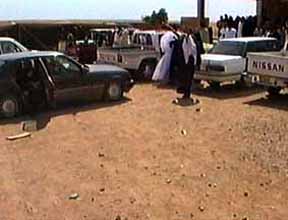
TV image shows the bride in white arriving
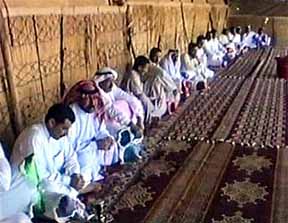
TV image of the male guests
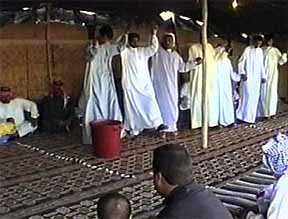
TV image of the male guests
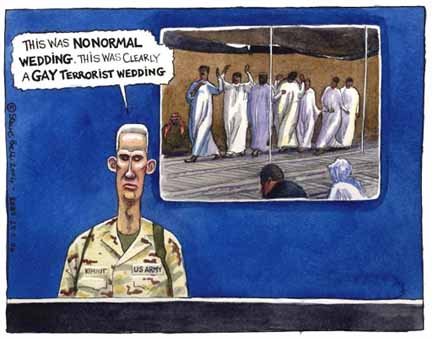
Cartoon in The Guardian by Steve Bell

TV image of the male guests
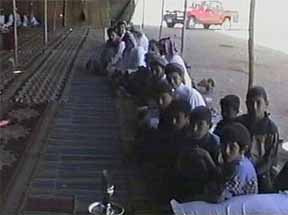
TV image of the male guests
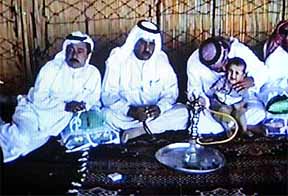
TV image of men with a baby at the wedding
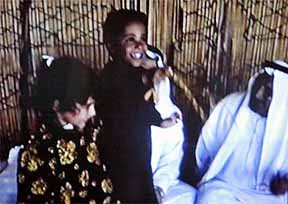
TV image of a boy and a girl at the wedding
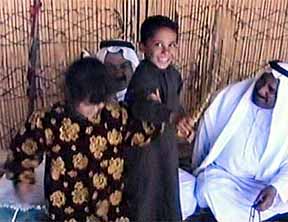
TV image of a boy and a girl at the wedding

Keyboard player at the wedding

Keyboard player, dead and
buried the next day in Ramadi wearing the same tan-colored clothes
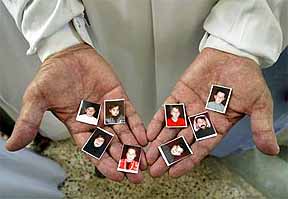
Iraqi Mahdi Nawaf shows photographs of dead
family members during a funeral ceremony in Ramadi.
Mahdi said they were were killed Wednesday, when a U.S. helicopter fired on a
wedding party
in the remote desert near the border with Syria killing more than 40
people.
The photographs show: Iraqi father Mohammed Al-Rikad, right, his wife Morifa,
left,
and their children Saad, 10, Fasila, 7, Faisal, 5, Anoud, 6, Kholood, 4 and
three year-old Inad.
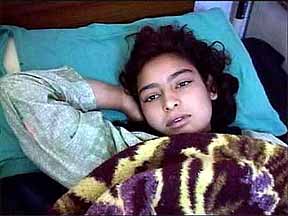
A video image shows a wounded child laying in a
hospital
in Ramadi, May 20, 2004, after having her leg amputated.
She was the sister of the bridegroom
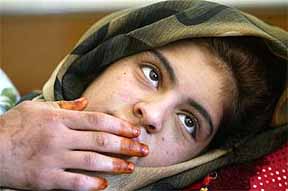
Iraqi girl Moza Rikad, 14, in Ramadi hospital.
She was the stepsister of the bridegroom.
Moza has her fingers painted with henna, a wedding tradition.
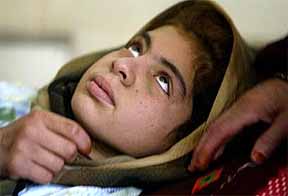
Iraqi girl Moza Rikad, 14, in Ramadi hospital.
She was the stepsister of the bridegroom.

Seven year-old Iraqi boy Akil is attended by his
father in the hospital in Ramadi.
Akil has been unsconscious for five days after shrapnel
entered his head which couldn't be all removed
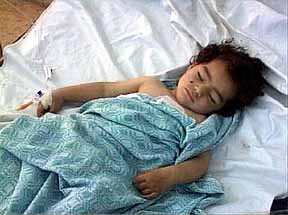
Iraqi girl Kholood, 2, lies in a bed in the hospital in Ramadi.
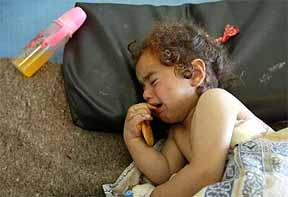
Iraqi girl Kholood, 2, lies in a bed in the hospital in Ramadi.
Kholood lost her parents and four of her brothers and sisters
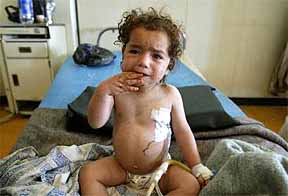
Iraqi girl Kholood, 2, lies in a bed in the hospital in Ramadi.
Kholood lost her parents and four of her brothers and sisters
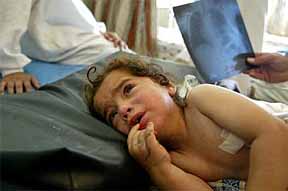
Iraqi girl Kholood, 2, lies in a bed in the hospital in Ramadi.
Kholood lost her parents and four of her brothers and sisters

Iraqi girl Kholood, 2, lies in a bed in the hospital in Ramadi.
Kholood lost her parents and four of her brothers and sisters

Iraqi woman Haleema Shihab, 32, lies with a fractured leg and arm in the
hospital in Ramadi.
Haleema ran with her youngest child in her arms and her two other boys close
behind,
when a shell exploded next to her, killing her two sons.
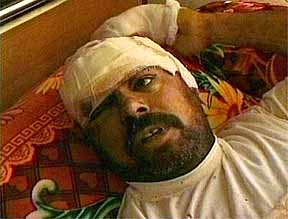
Adel Ragabis seen in this TV image on his
hospital bed in Qaim General Hospital.
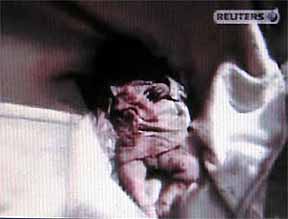
Reuters film of dead baby wrapped in funeral shroud
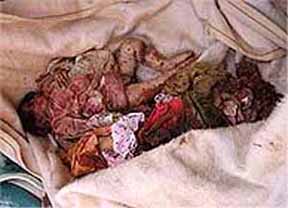
AFP photo of two dead children
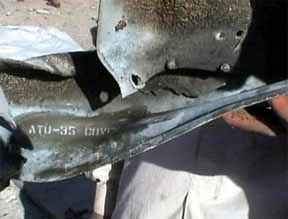
Metals parts from American missiles found at Mogr el-Deeb, Iraq
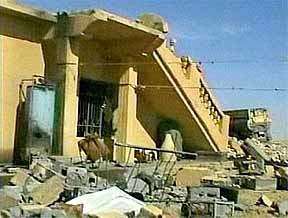
Damaged main building
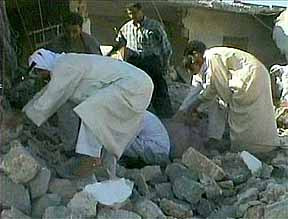
Searching for dead bodies in the rubble

TV shot of the tent that Brig. Gen. Mark Kimmitt
insisted did not exist

TV shot of destroyed tent
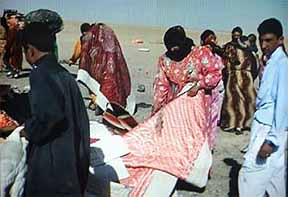
TV Image shows Iraqis removing belongings of the
bridegroom

Taleb Nawaf buried his wife Amal and his two
daughters Anoud, 2, and Kholood, 1.
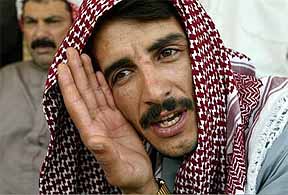
Khalid Mahdi explains that he was only able to
find parts of the head
of his one year old nephew Ra'ed.
Khalid had to bury as well his sister Fatima,
who died with her two year old son Raad in her arms
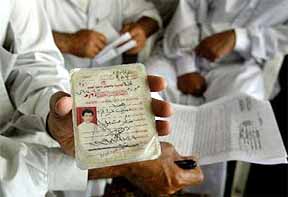
Members of the Rikad family show the identity card, left,
of wedding guest Hamid Nunif Ghazai next to the death certificates
of 27 members of the Rikad family

Looking the bodies onto pick-up trucks
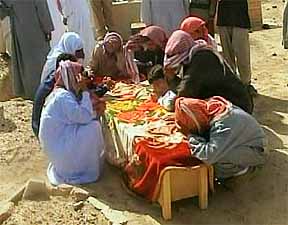
Burial at the cemetery in Ramadi

Burial at the cemetery in Ramadi
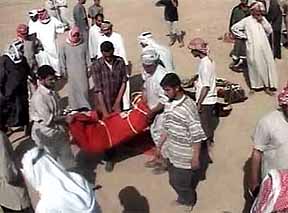
Burial at the cemetery in Ramadi

Burial at the cemetery in Ramadi
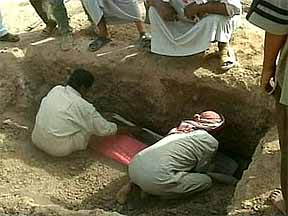
Burial at the cemetery in Ramadi

An Iraqi man points to the name of his wife
Fatima Rakad written
on a makeshift tombstone at a cemetery outside the city of Ramadi.
Rakad was killed with her two children

Burial of the wedding singer Hussein Ali and his brother in Baghdad

Burial of the wedding singer Hussein Ali and his brother in Baghdad

Iraqi women gather during a memorial marking the
seventh day of mourning in Baghdad
May 24, 2004 for Hussein Ali, a man who was killed during a trip to sing at a
wedding
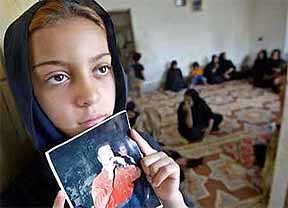
Iraqi girl Atiyaf Hussein, 12, holds a portrait
during a memorial
marking the seventh day of mourning in Baghdad May 24, 2004
for her father Hussein Ali, who was killed during a trip to sing at a wedding

Atiyaf Hussein, 12
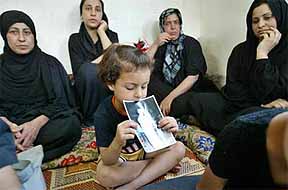
Iraqi girl Ziad, 4, holds a picture of her
killed uncle Iraqi musician Hussein al-Ali,
as she attends with Rabab Radif, right, wife of killed musician Muhanad al-Ali
and other familiy members